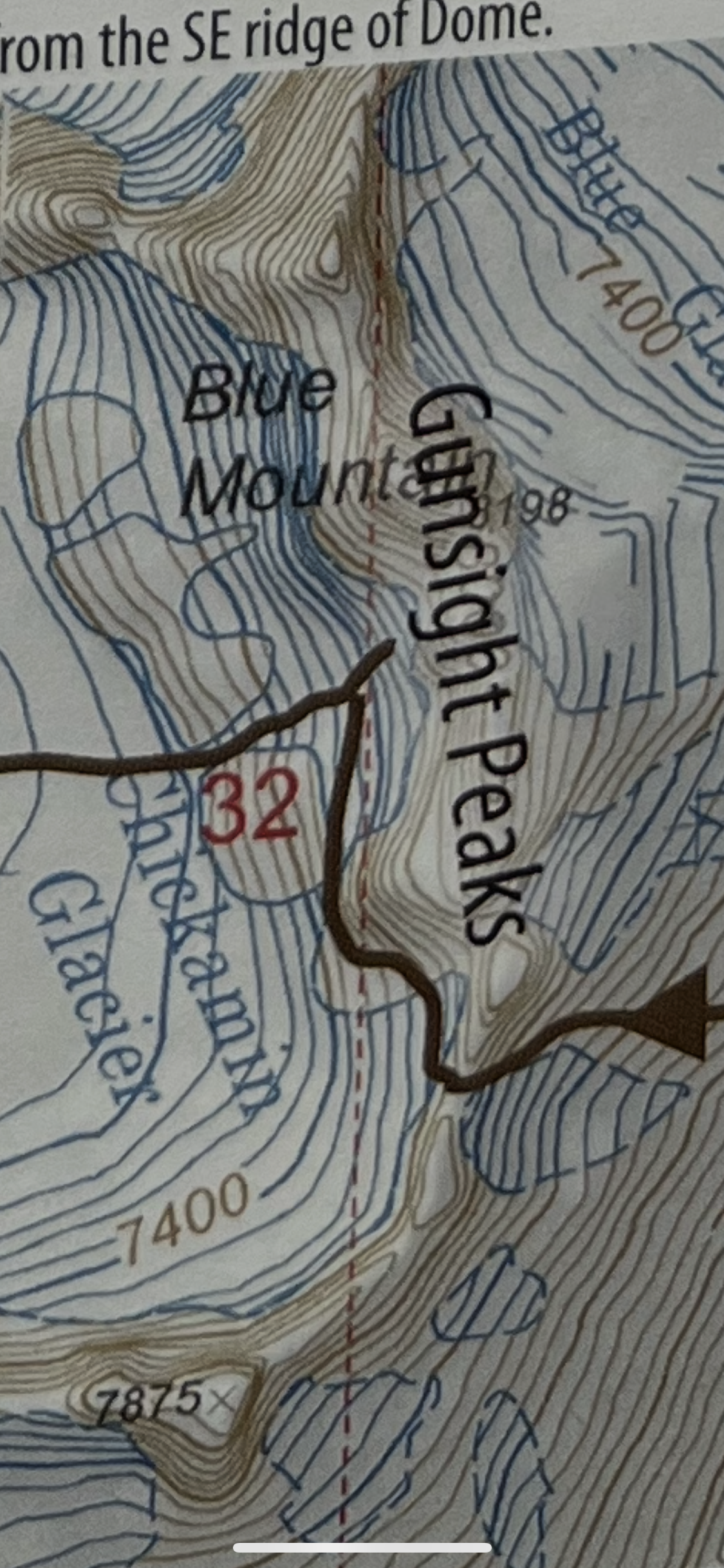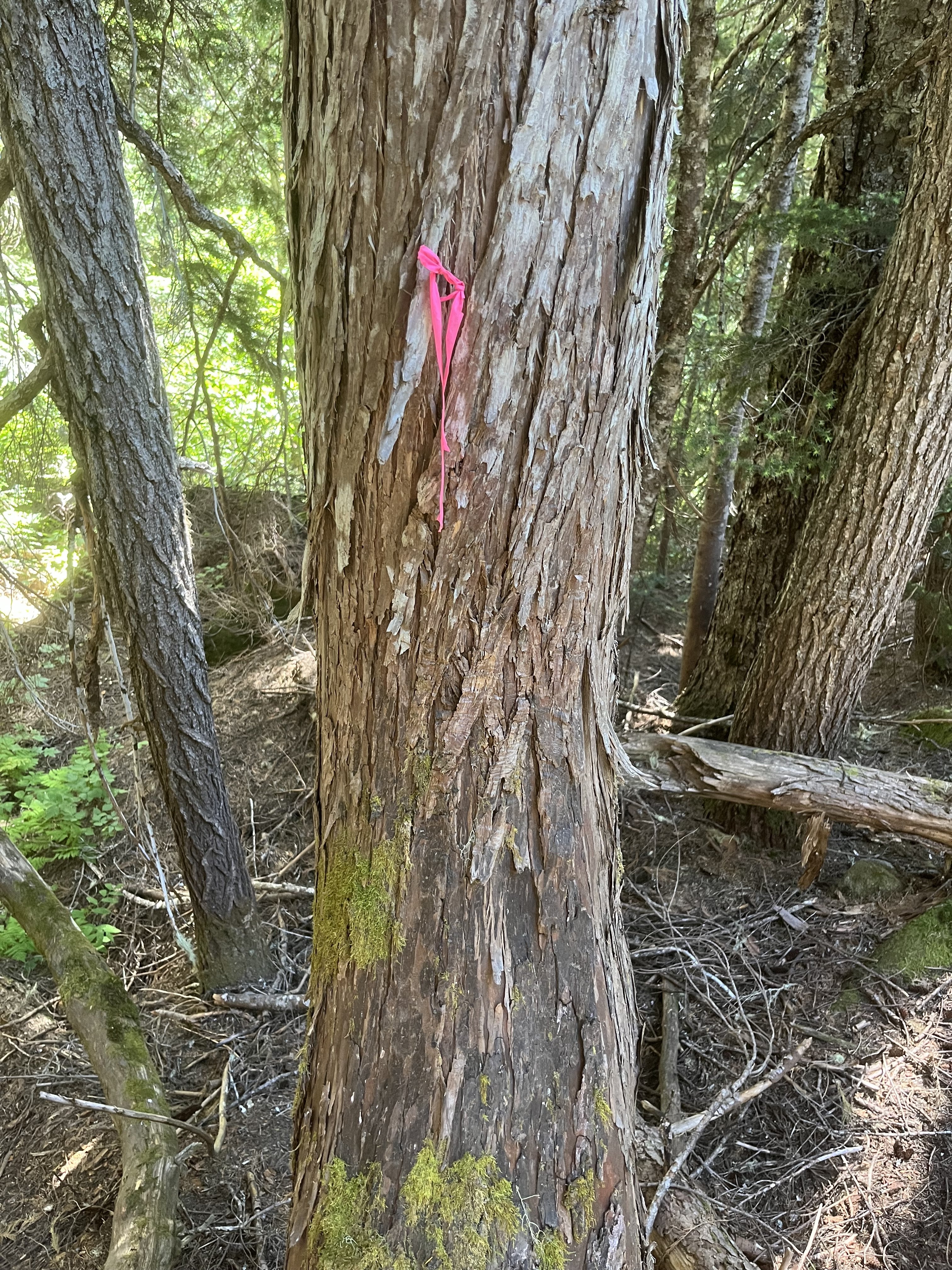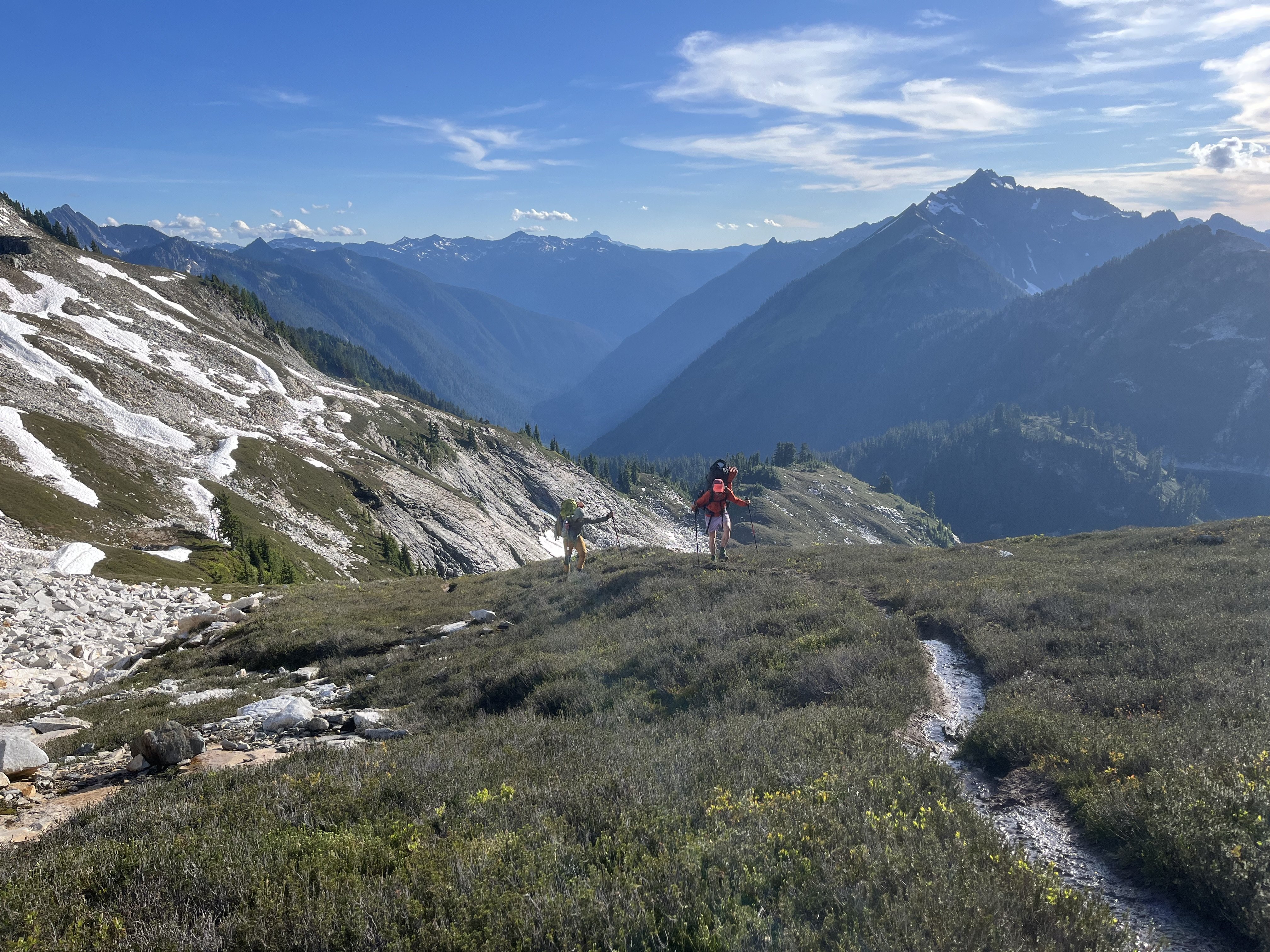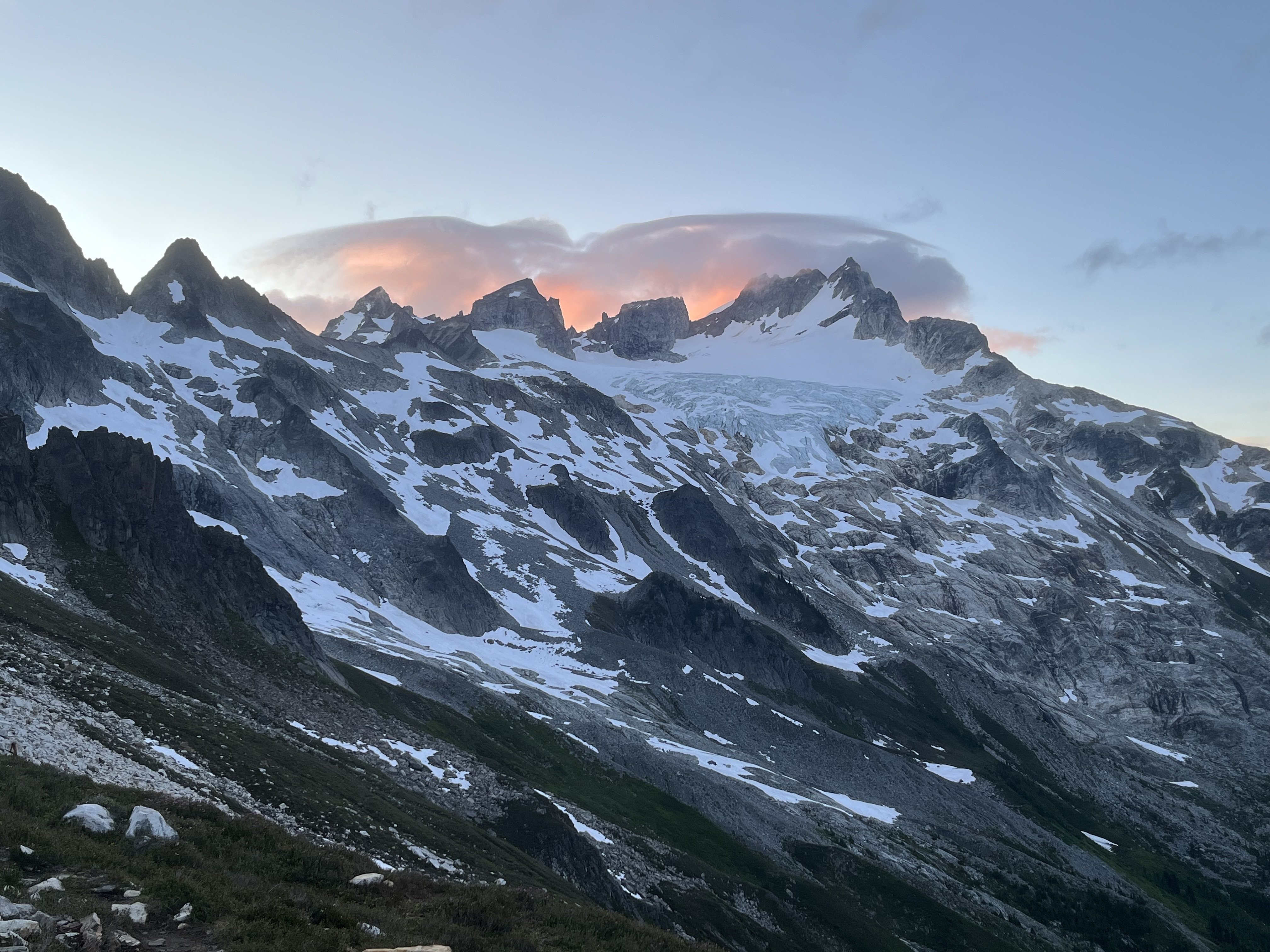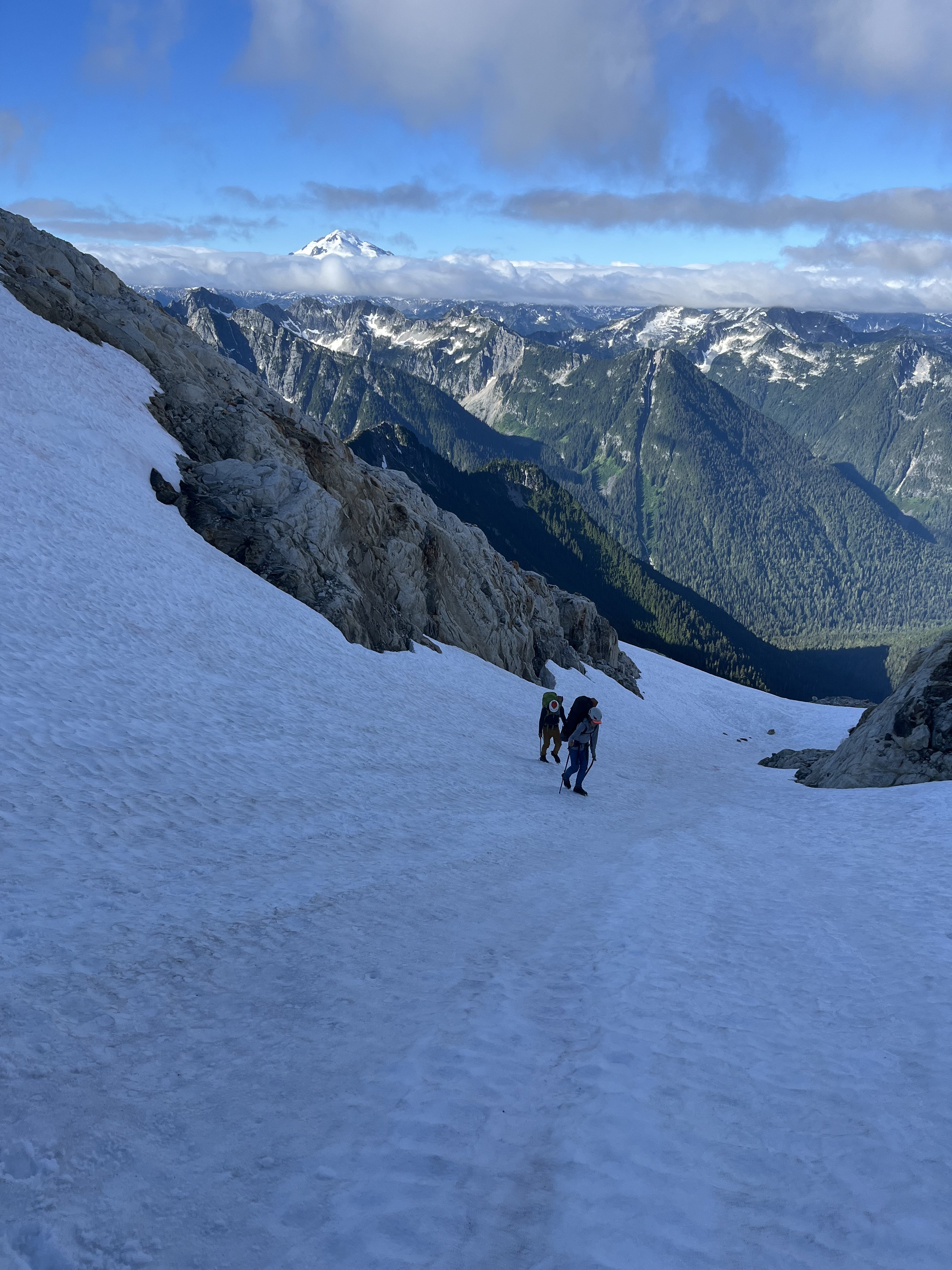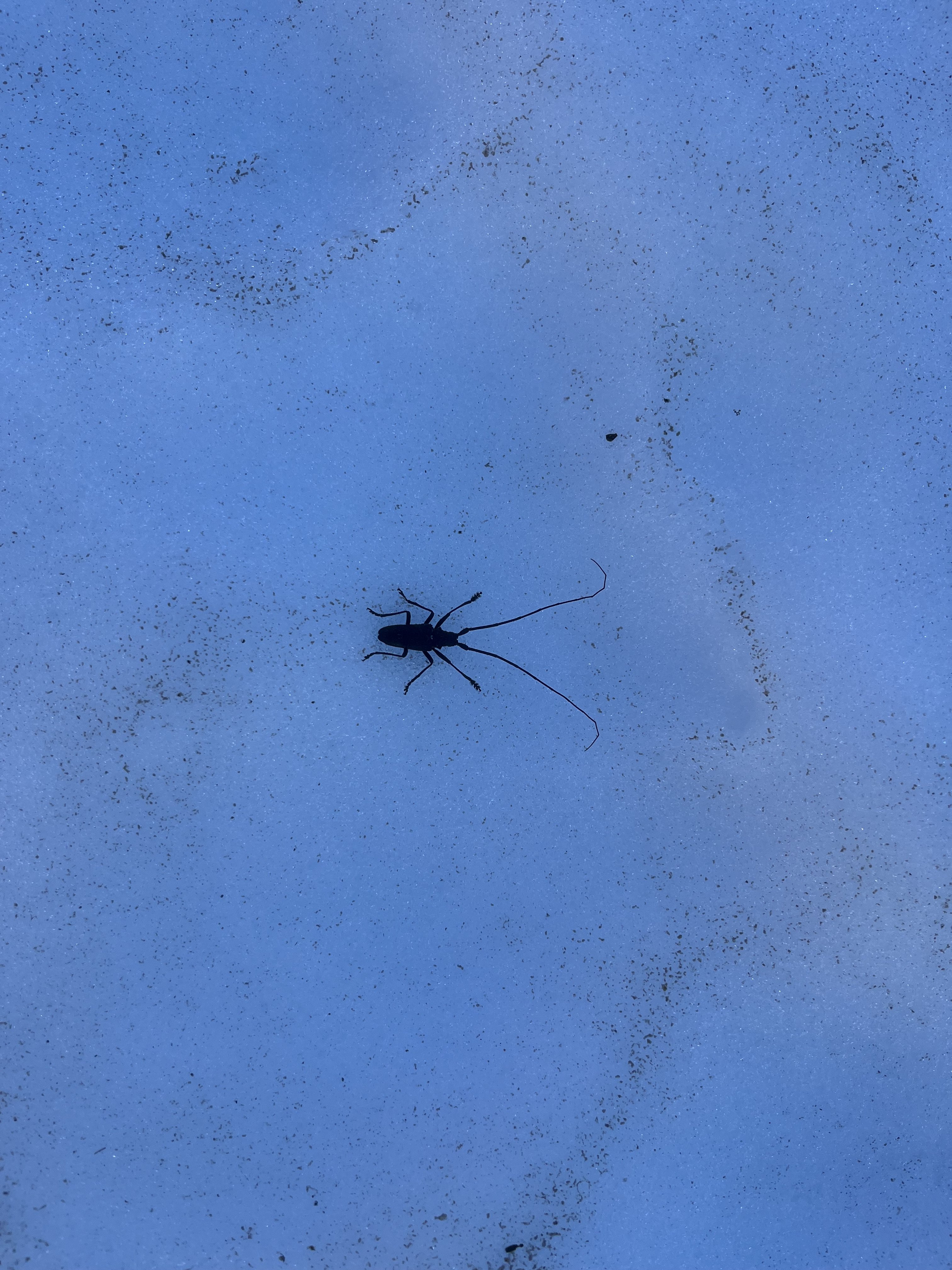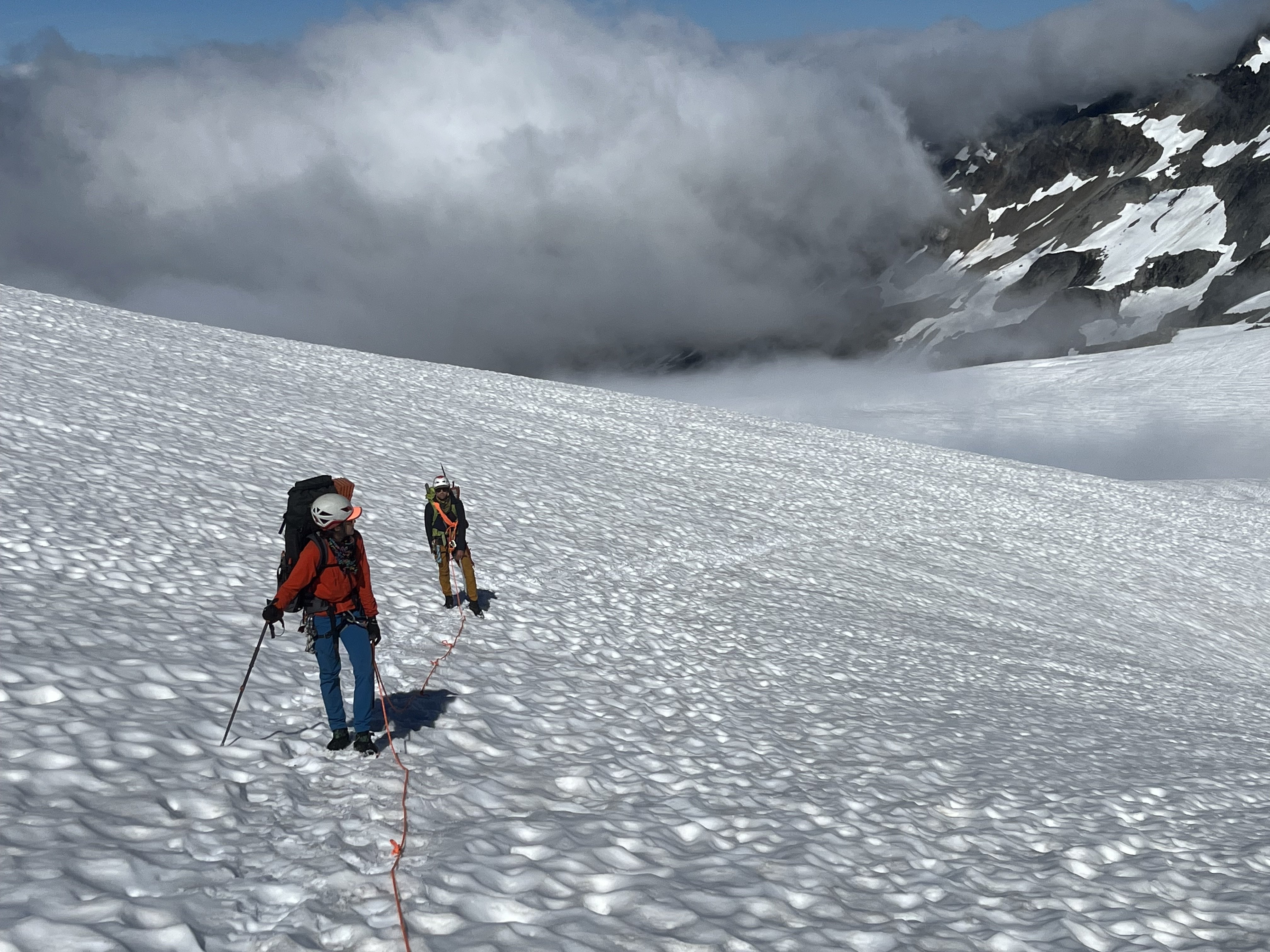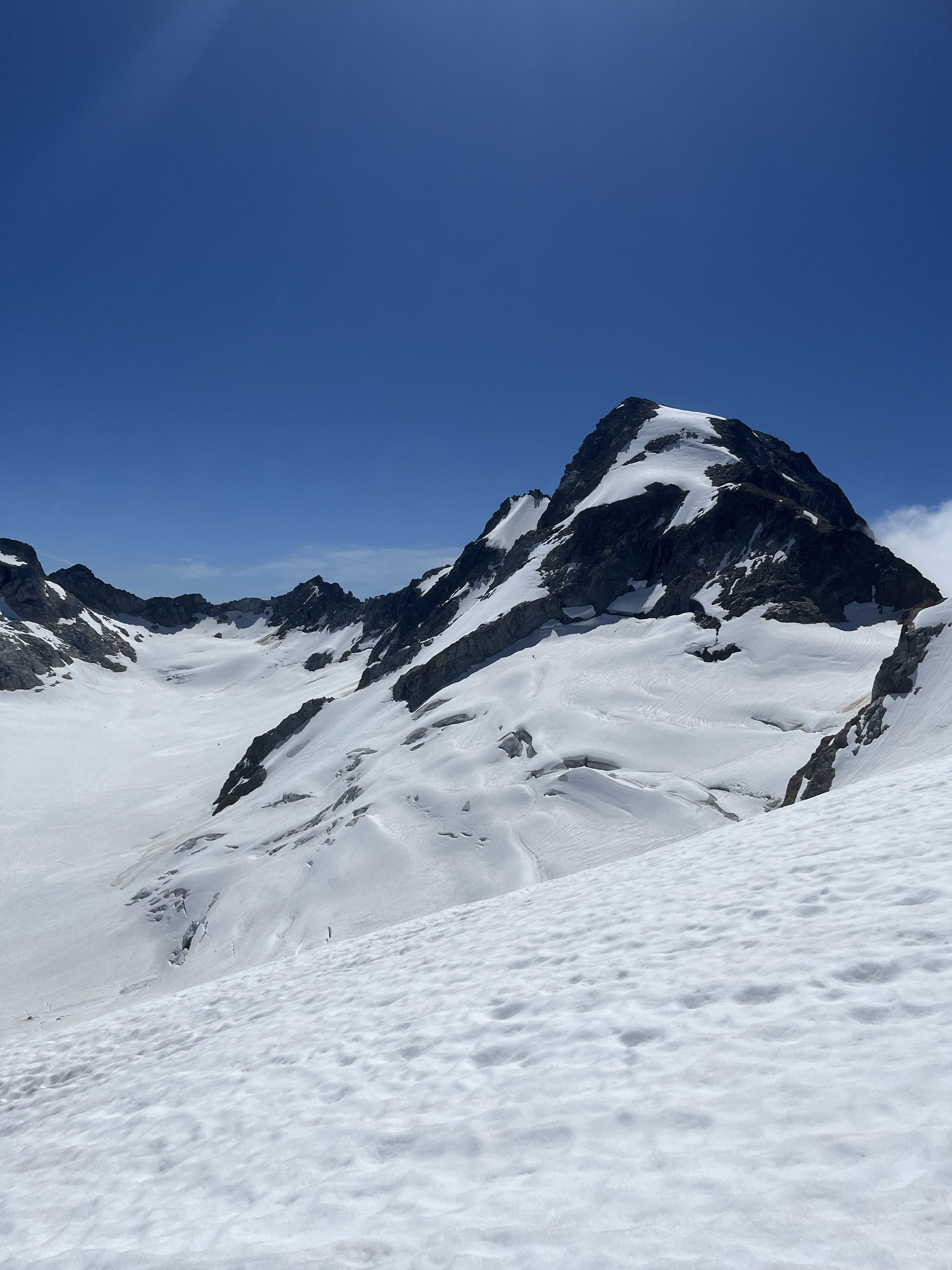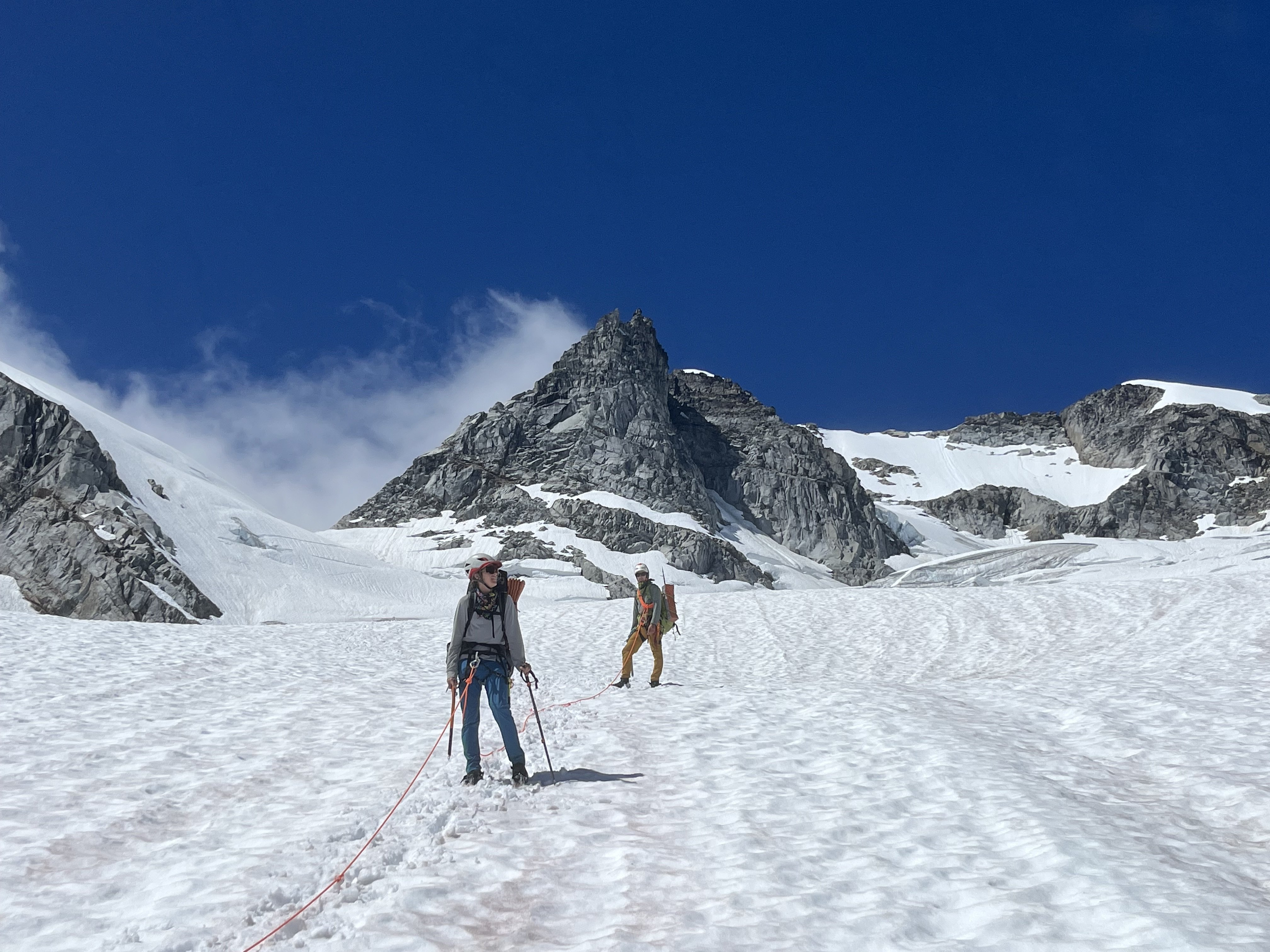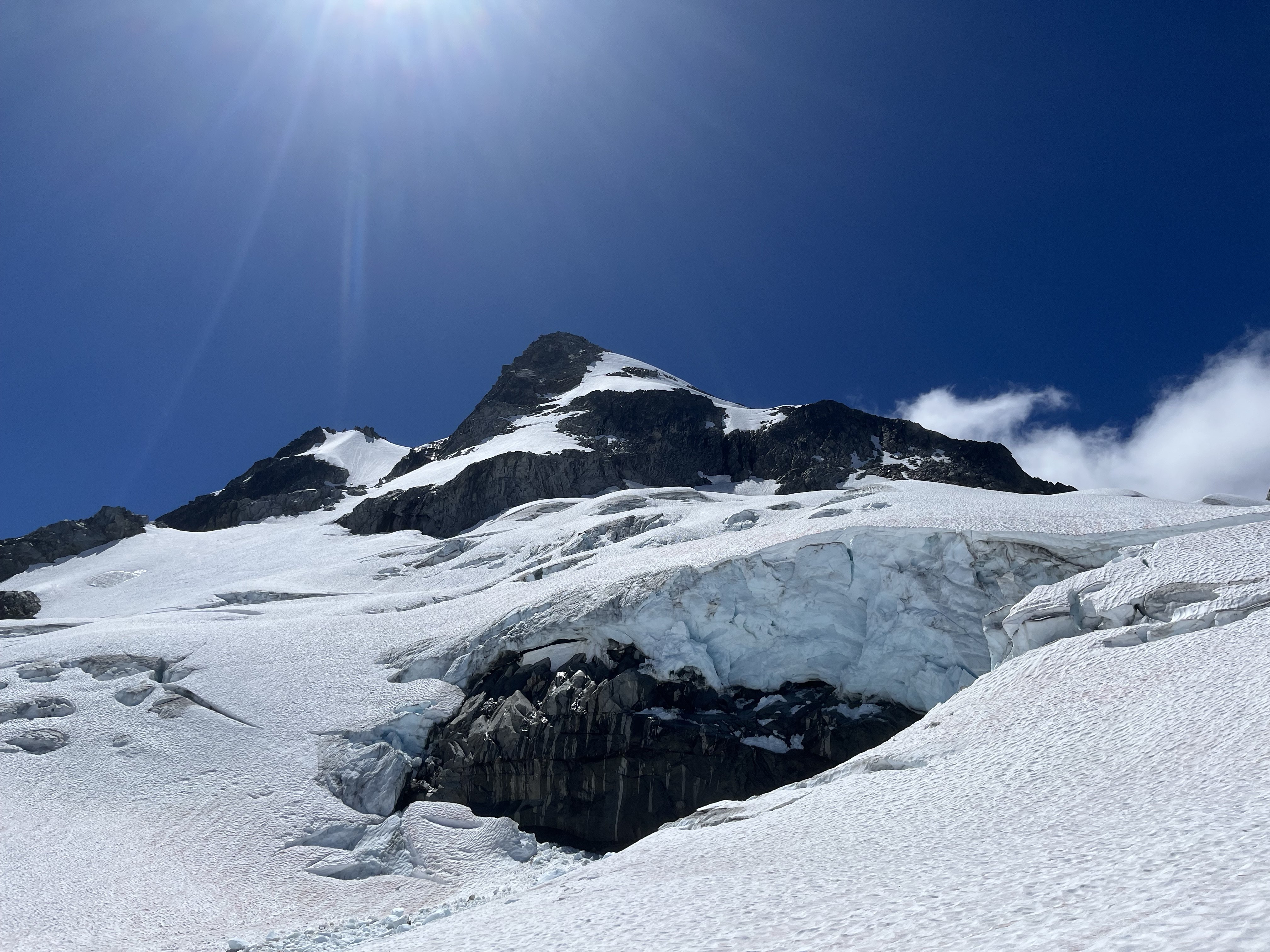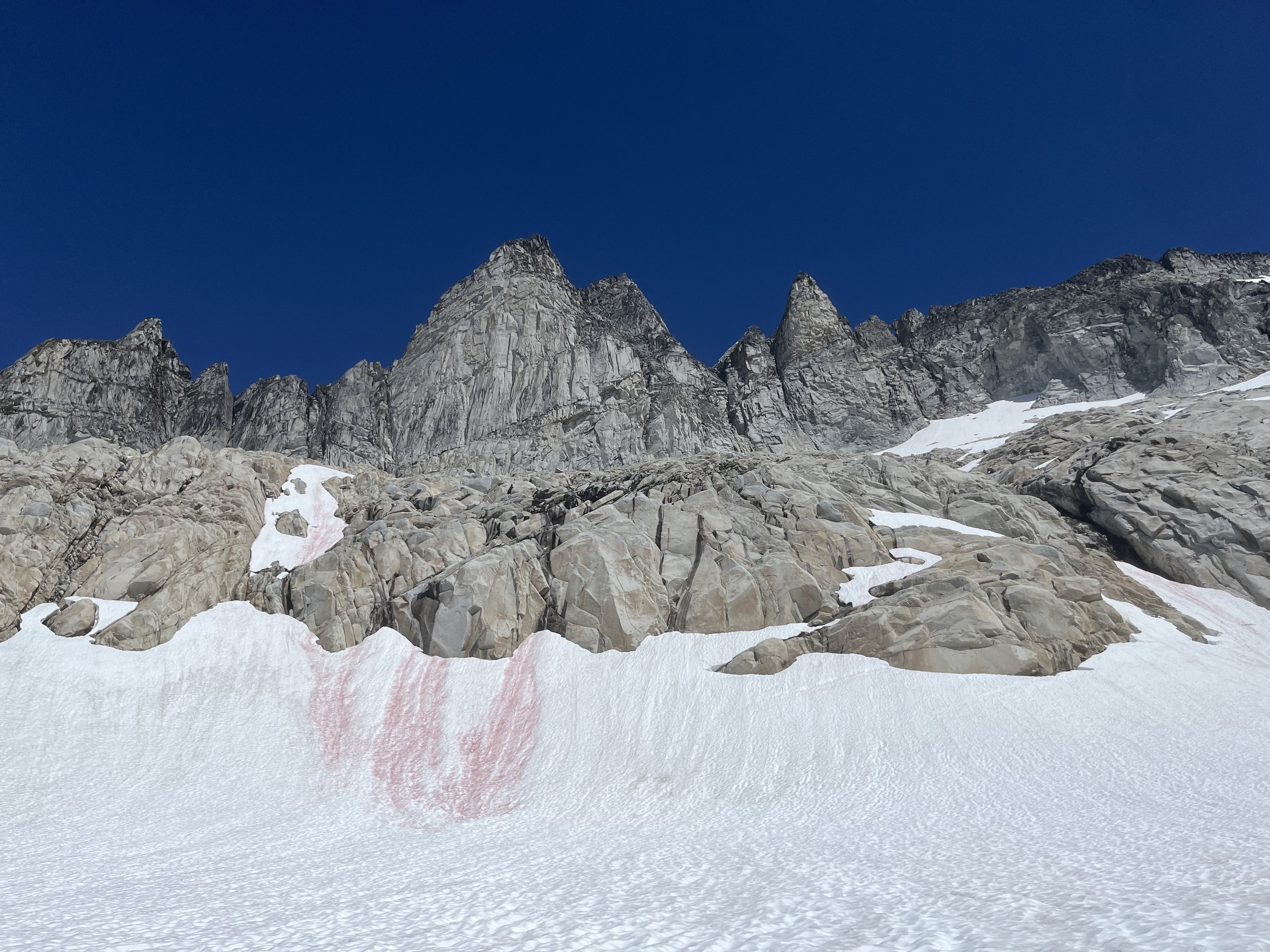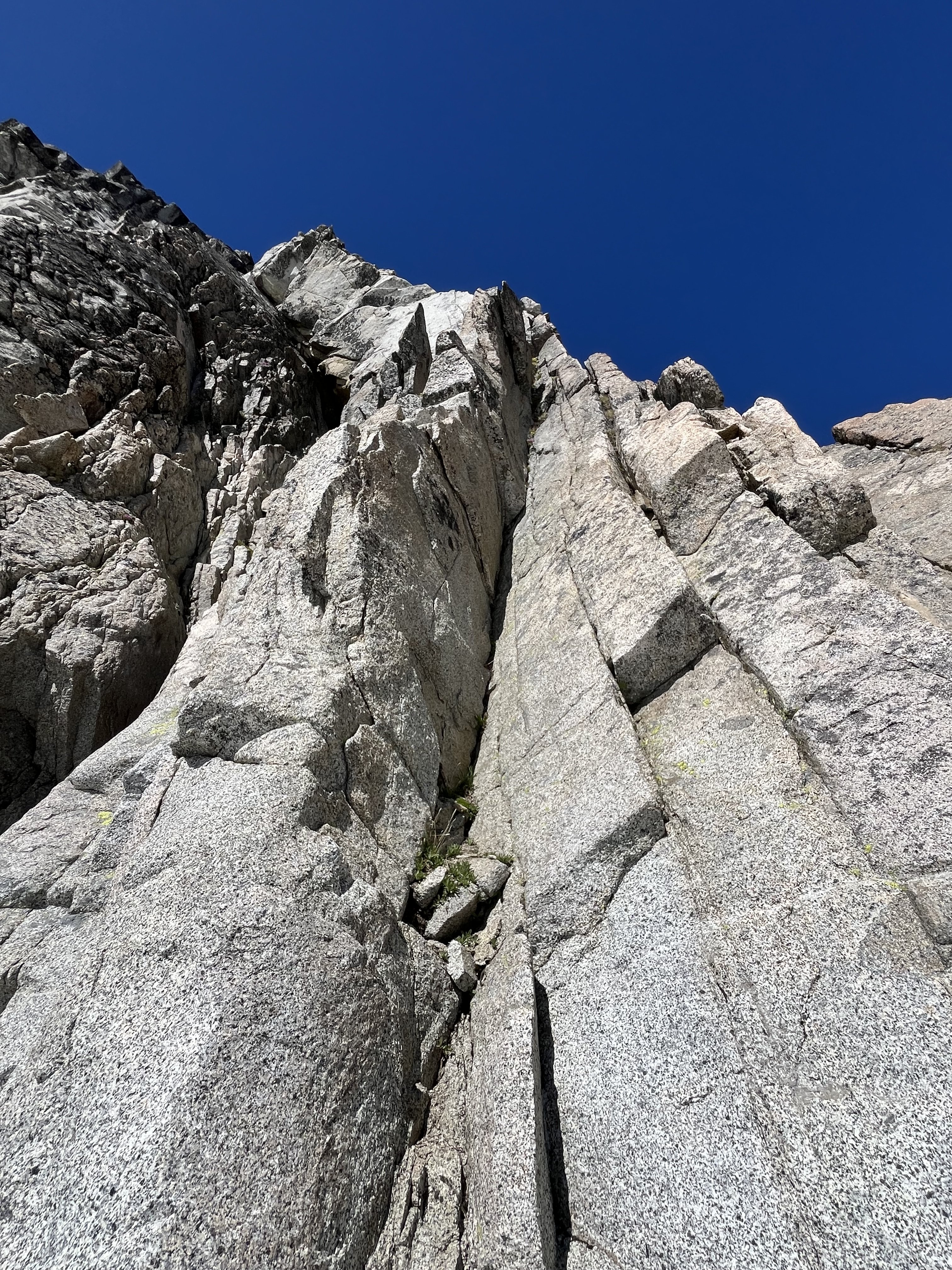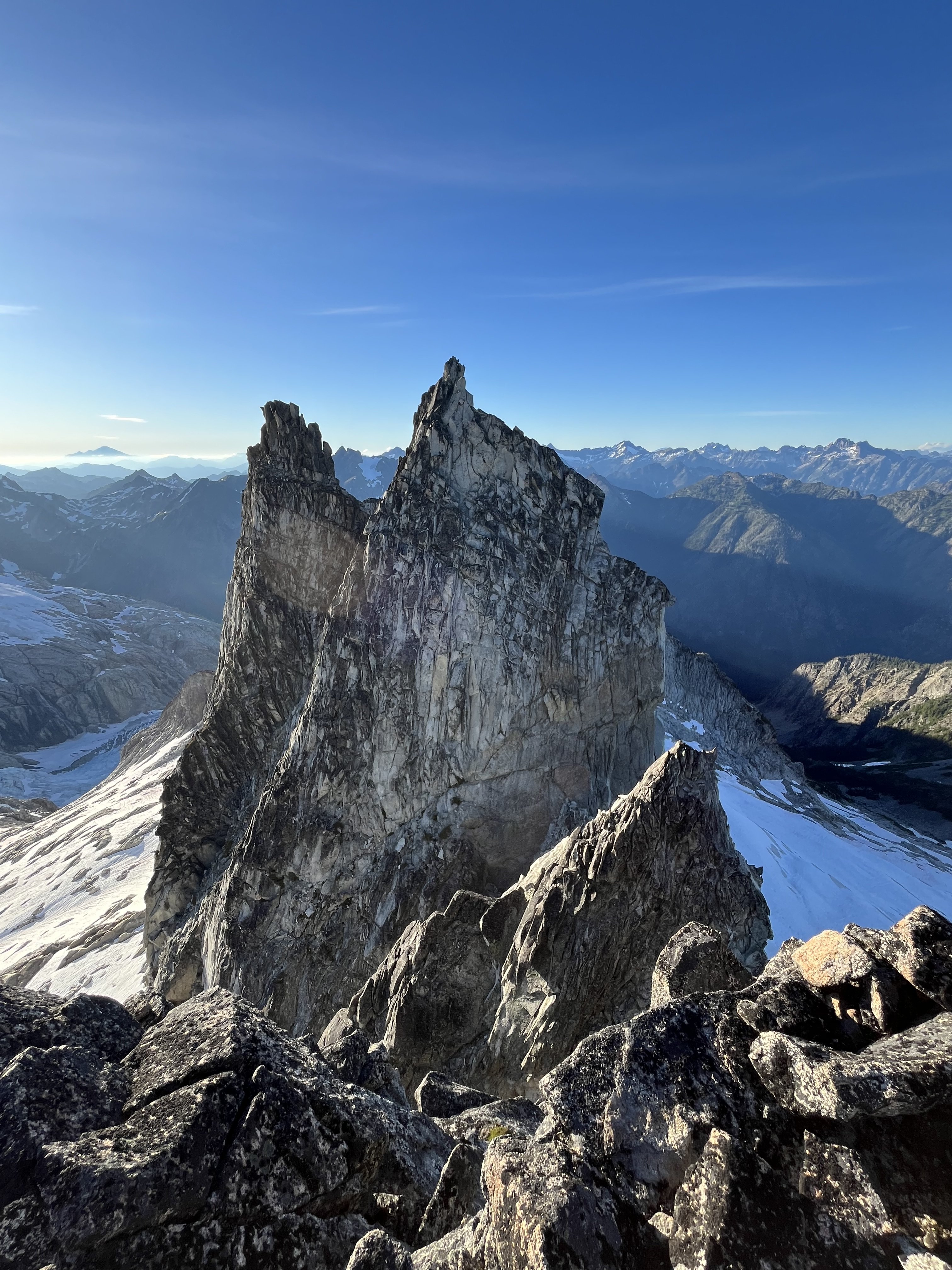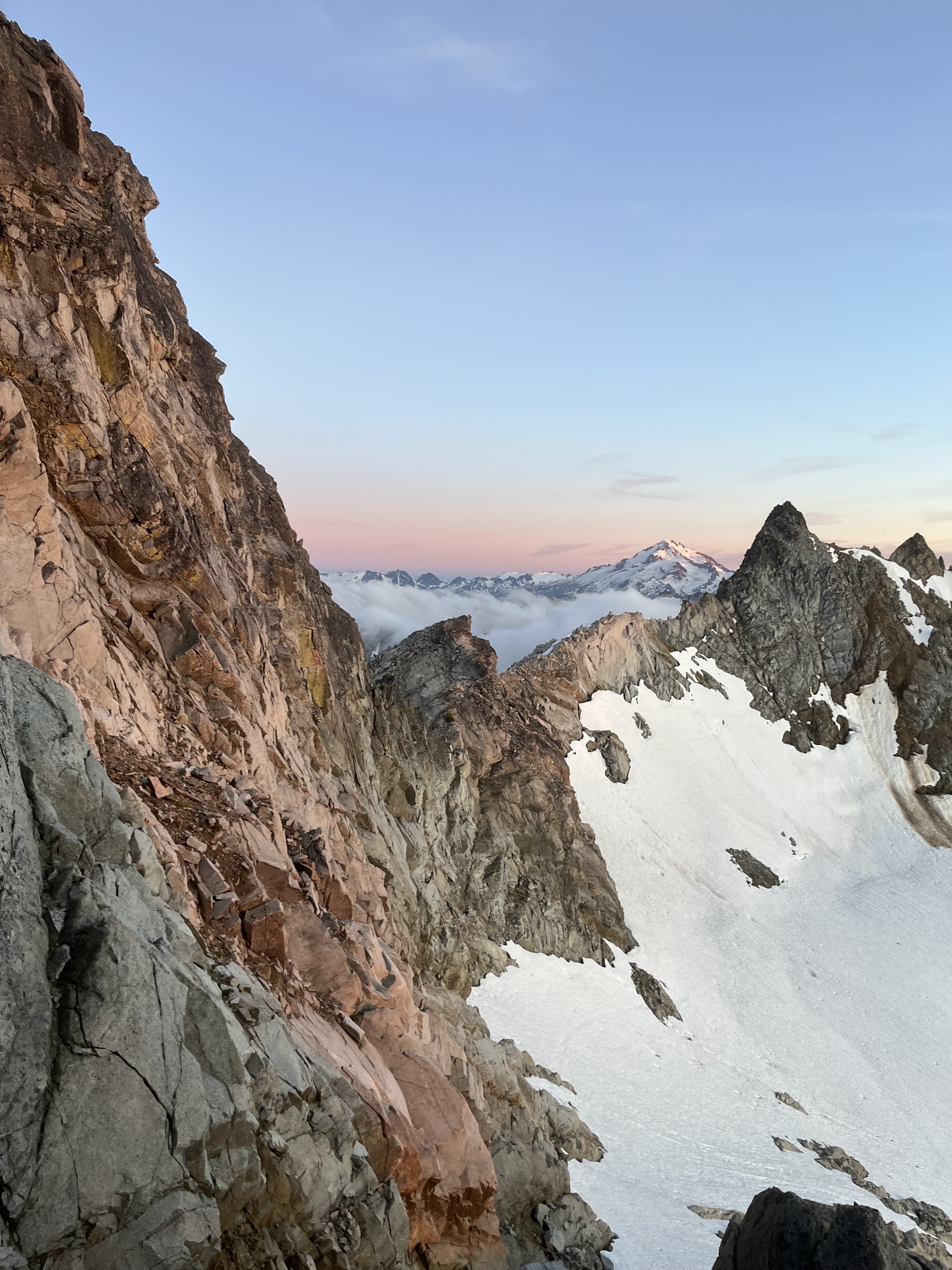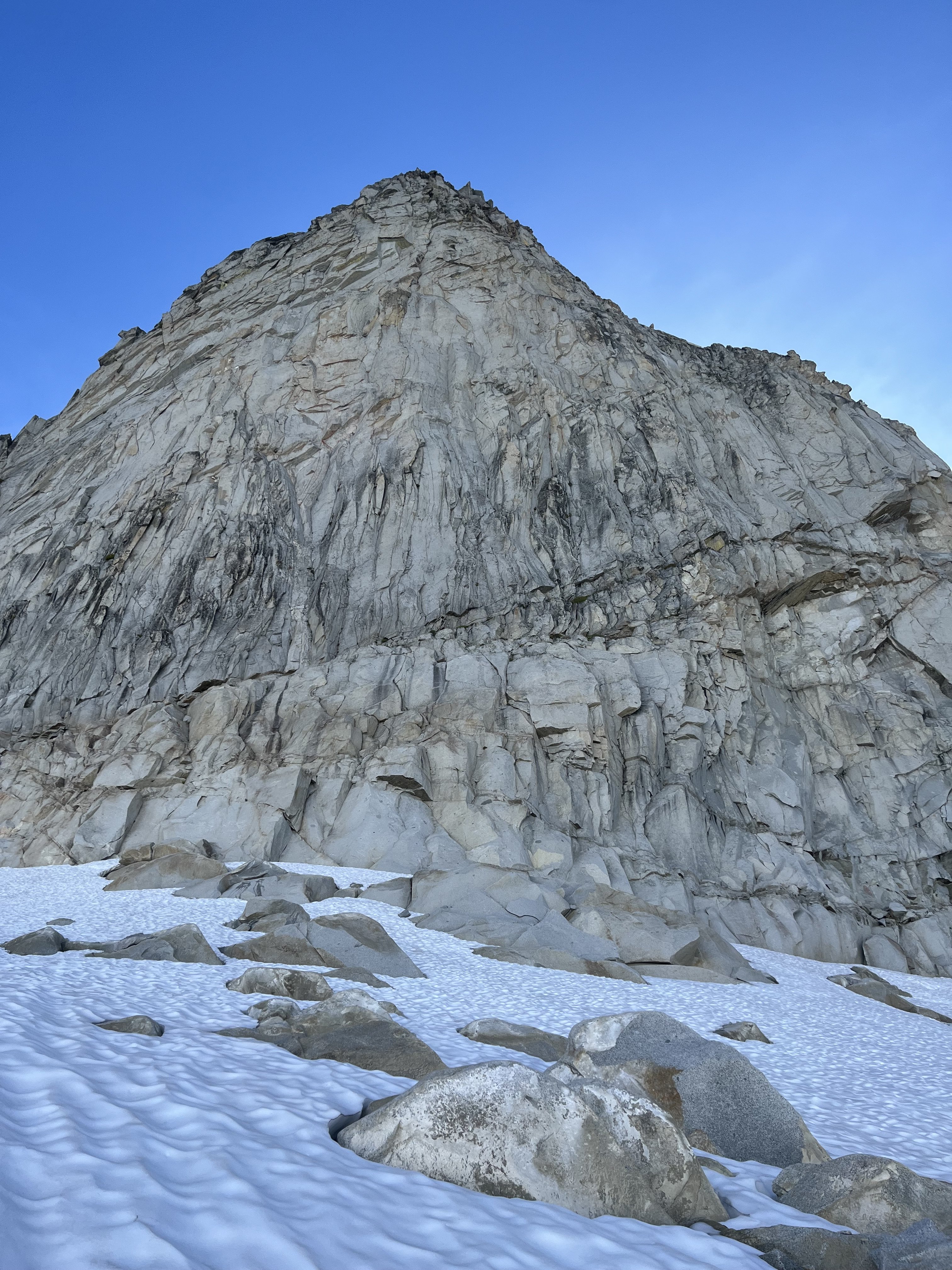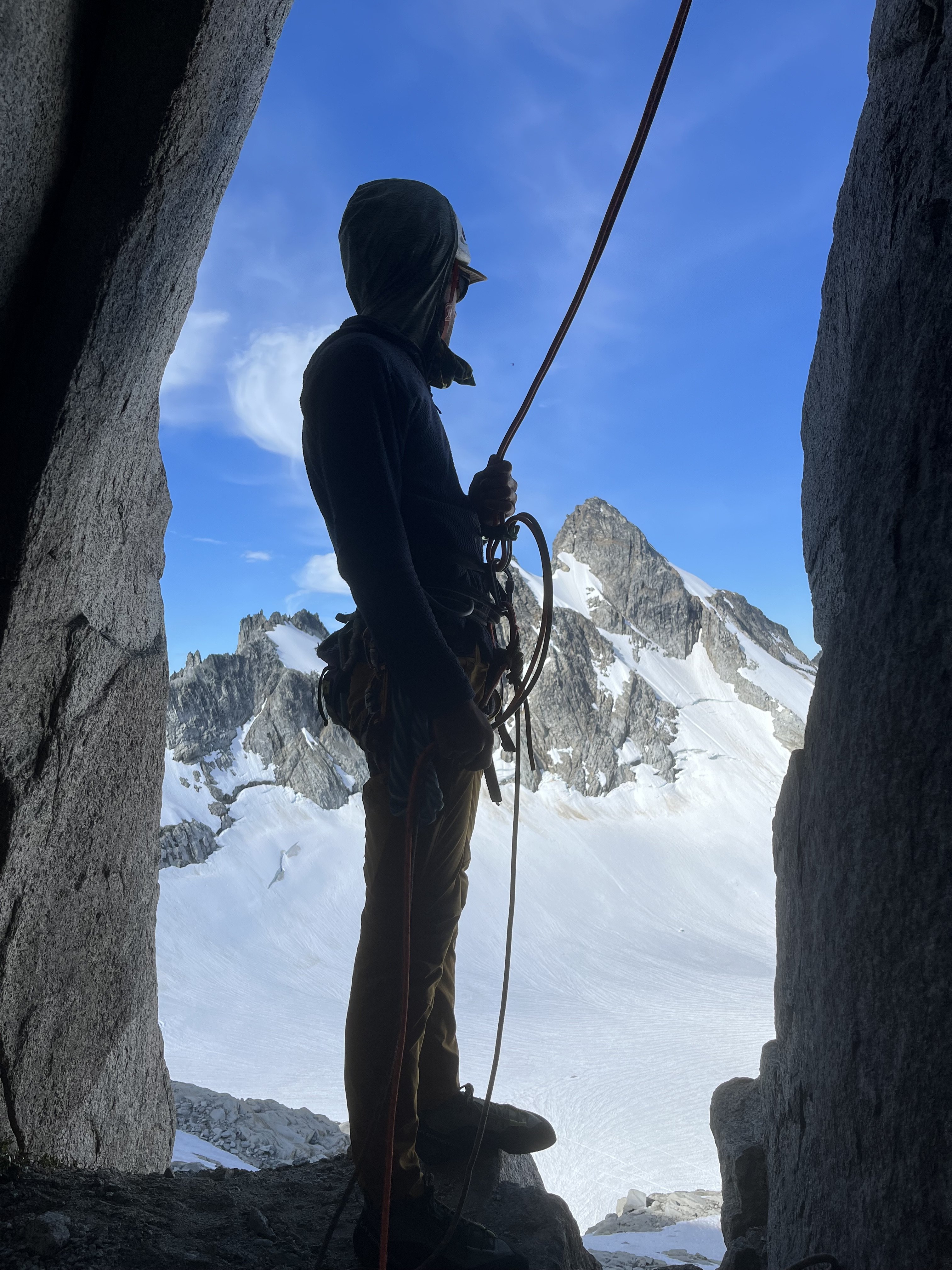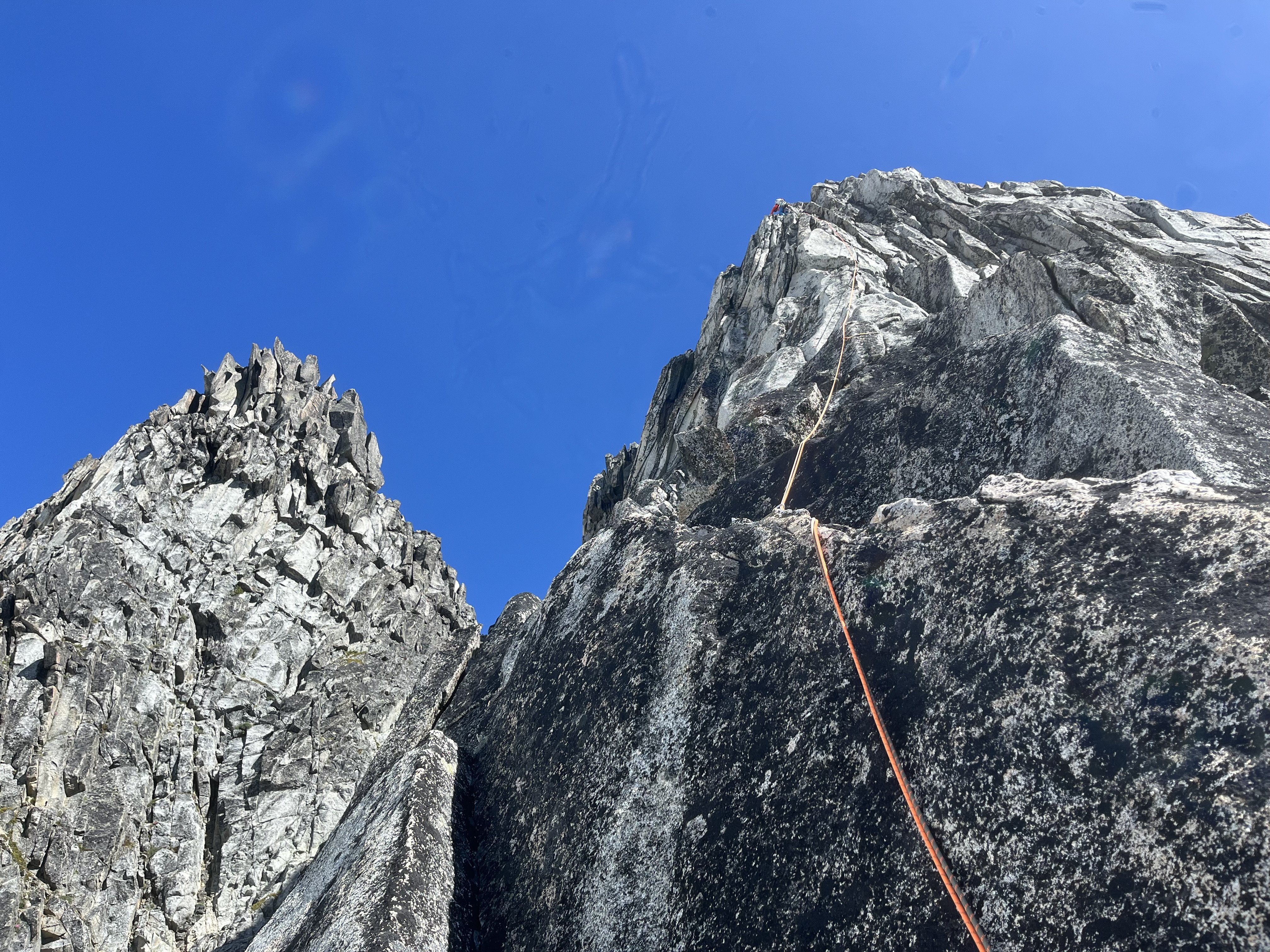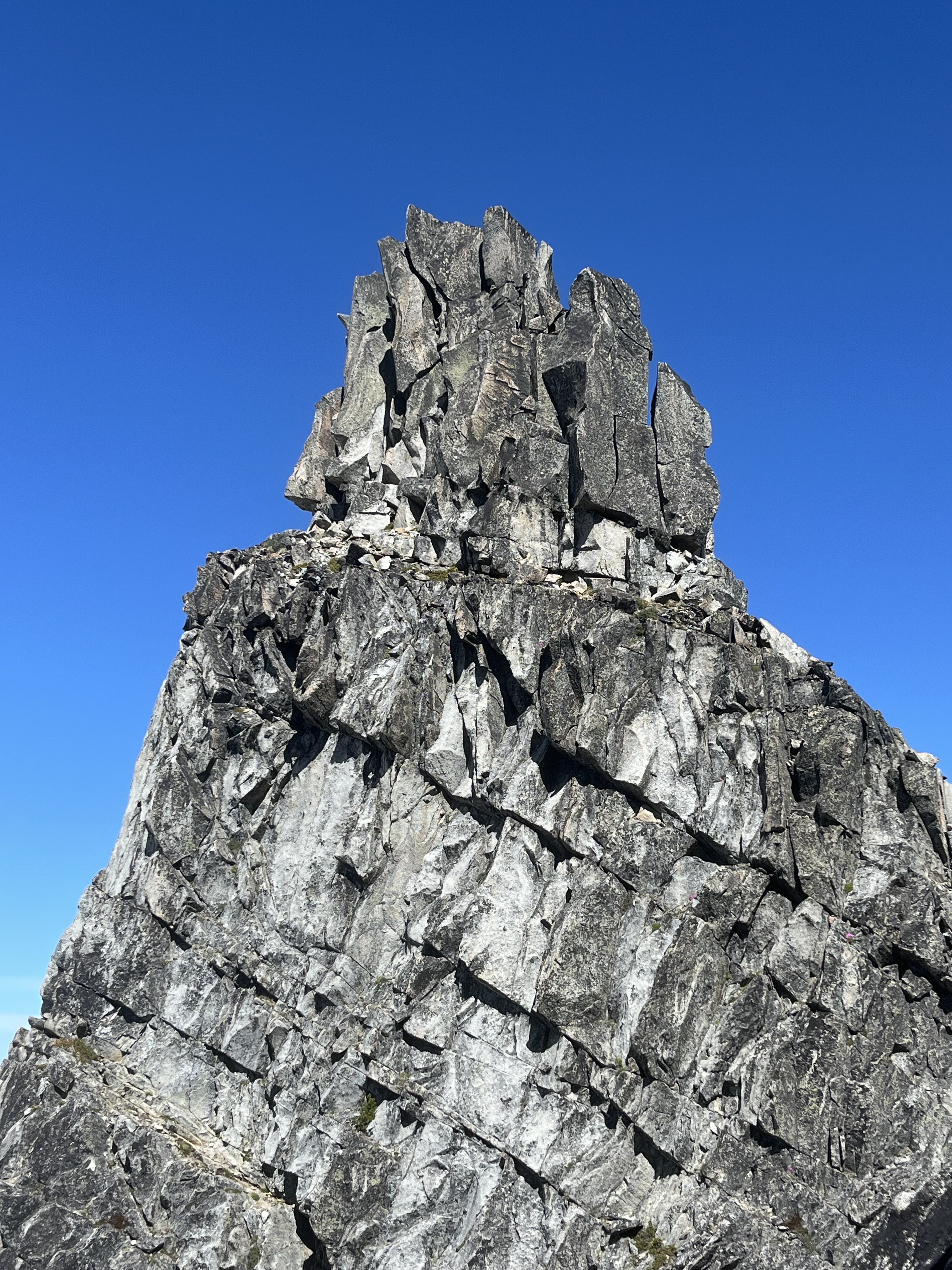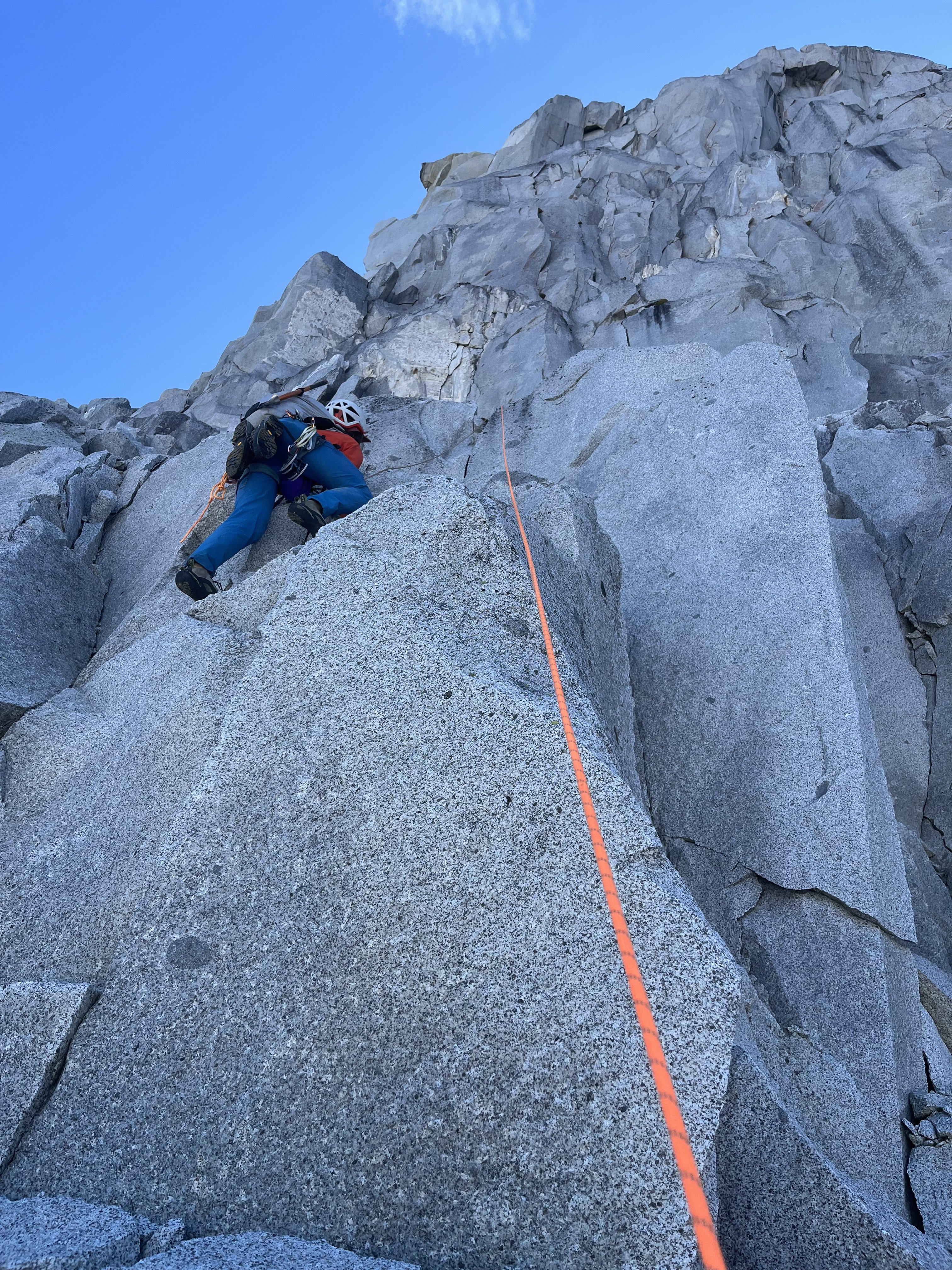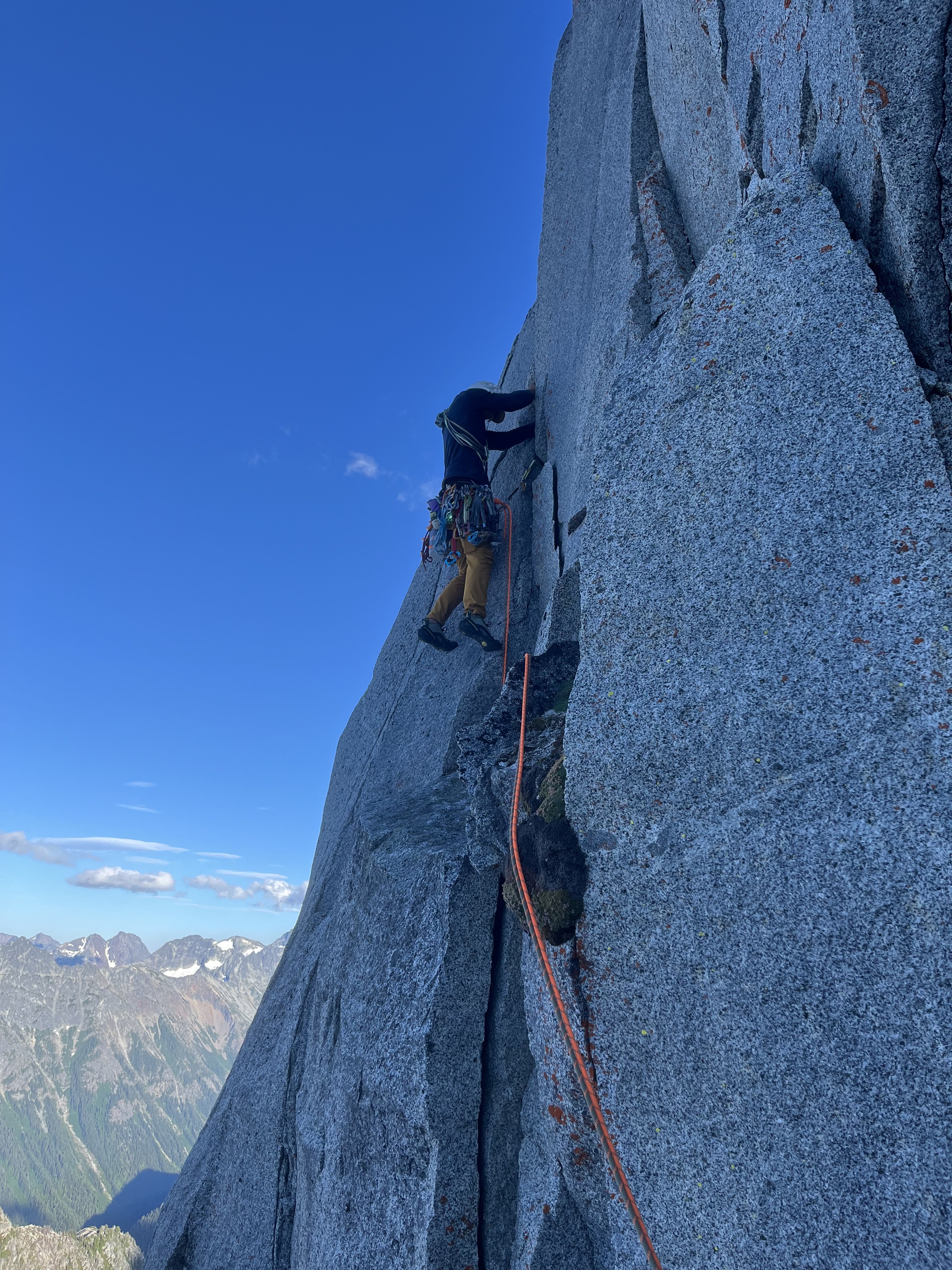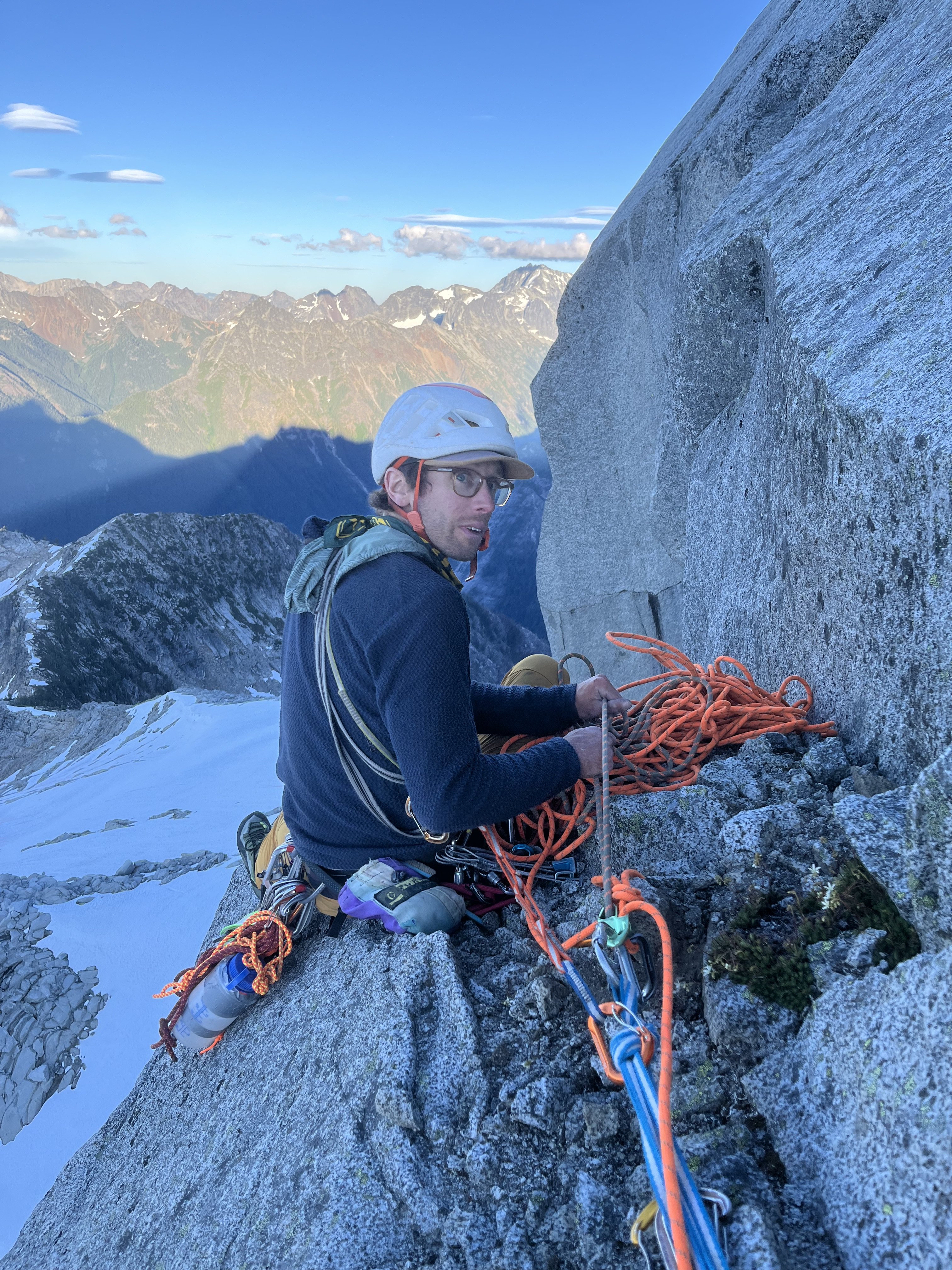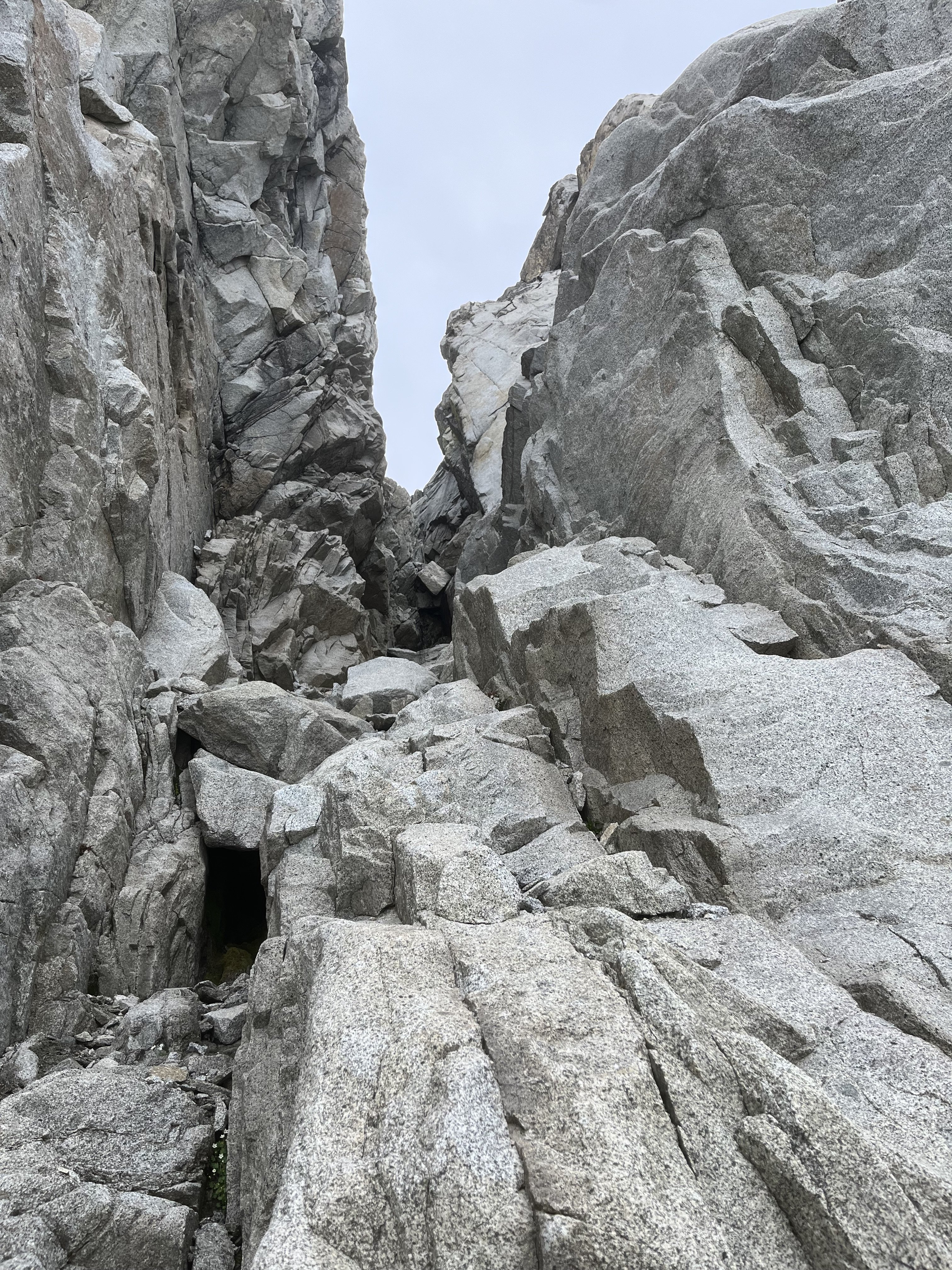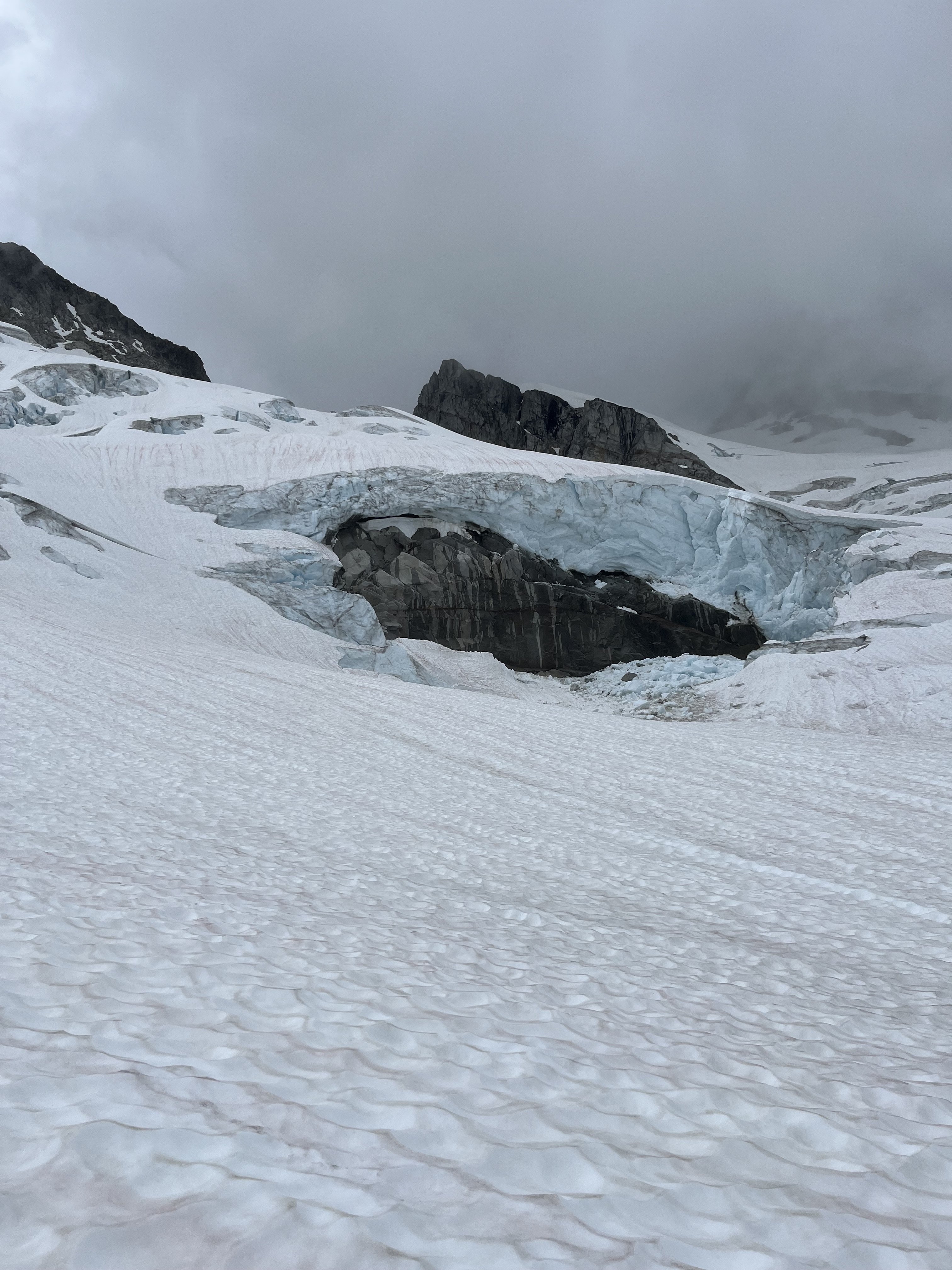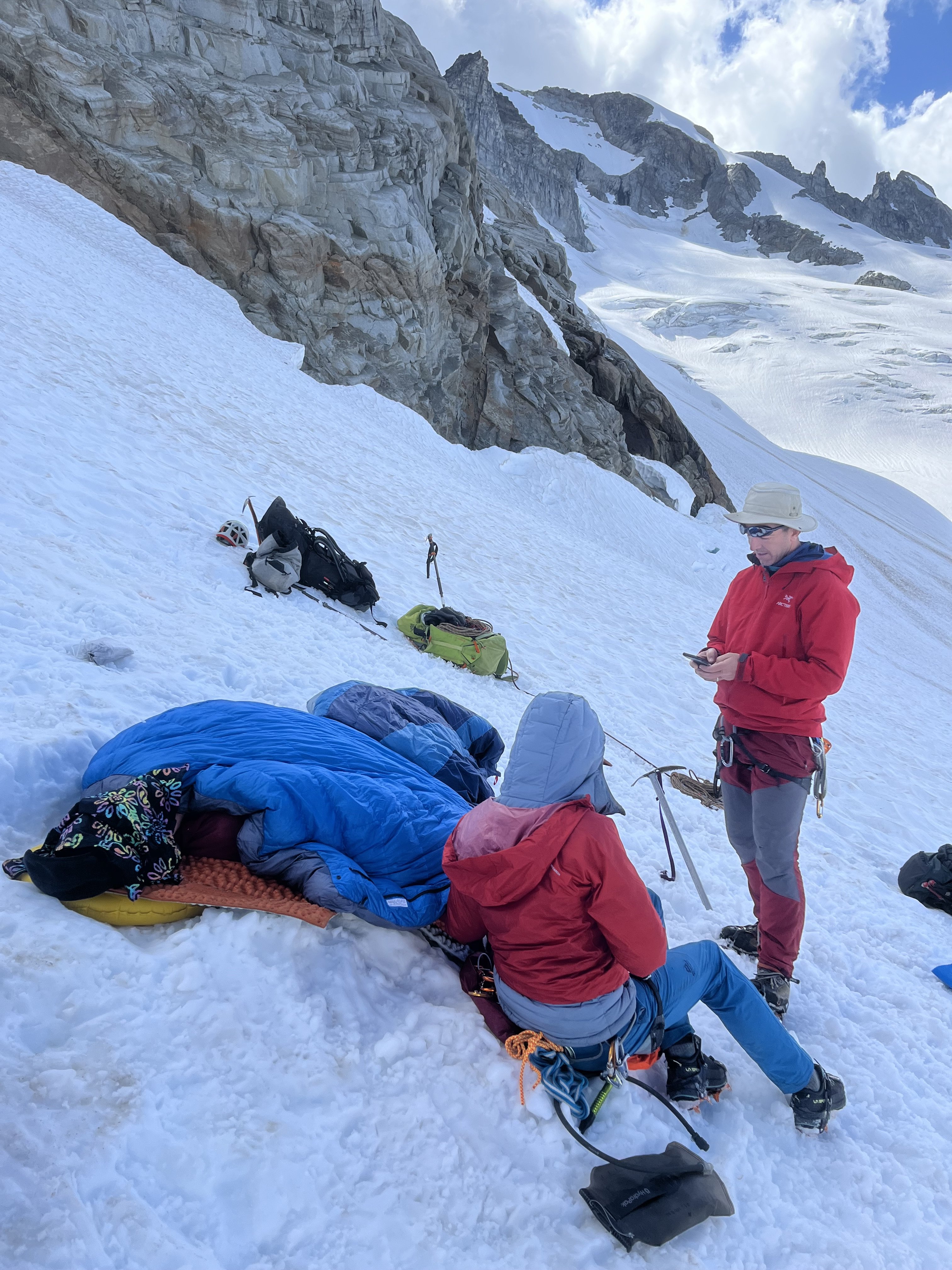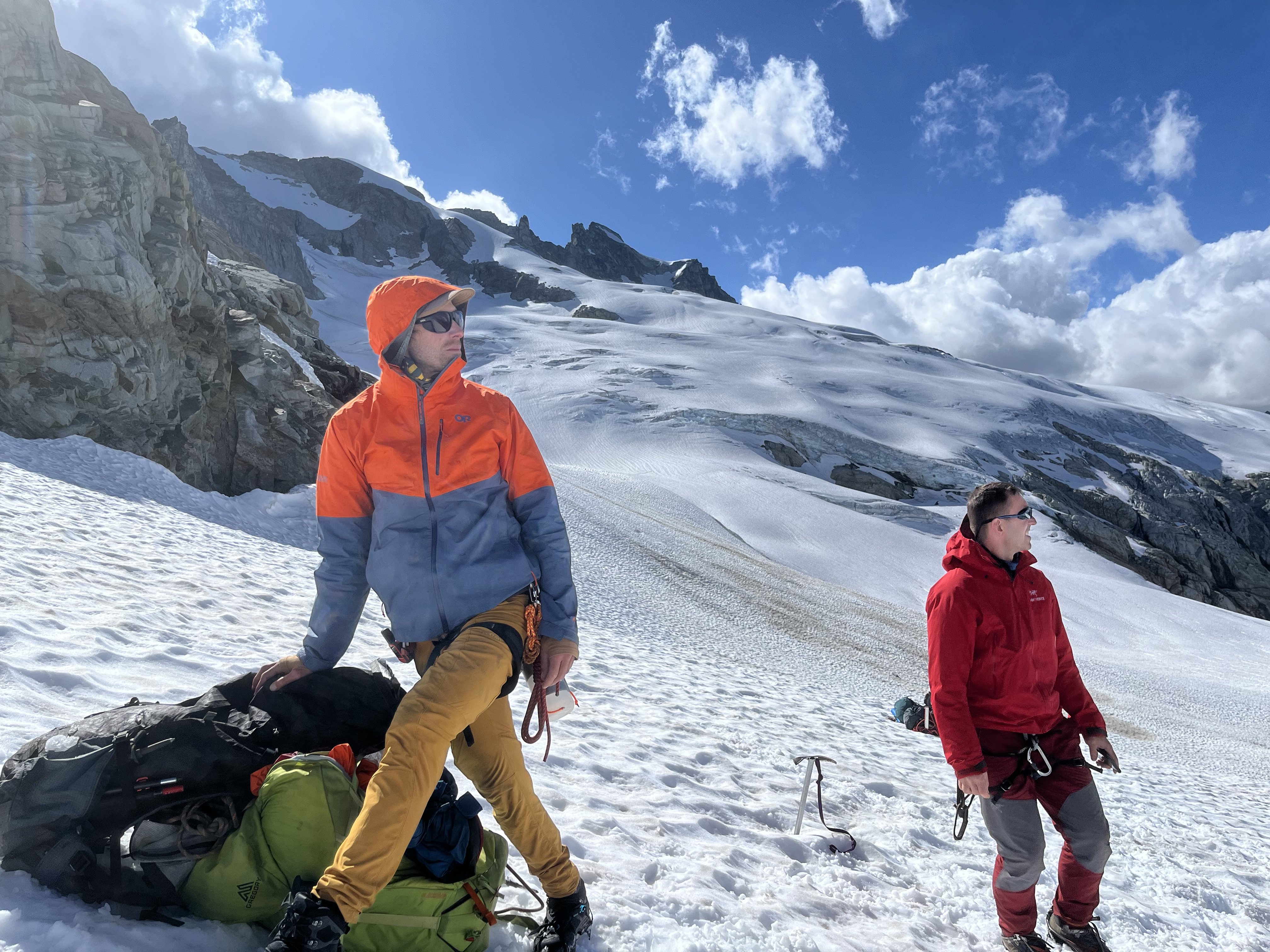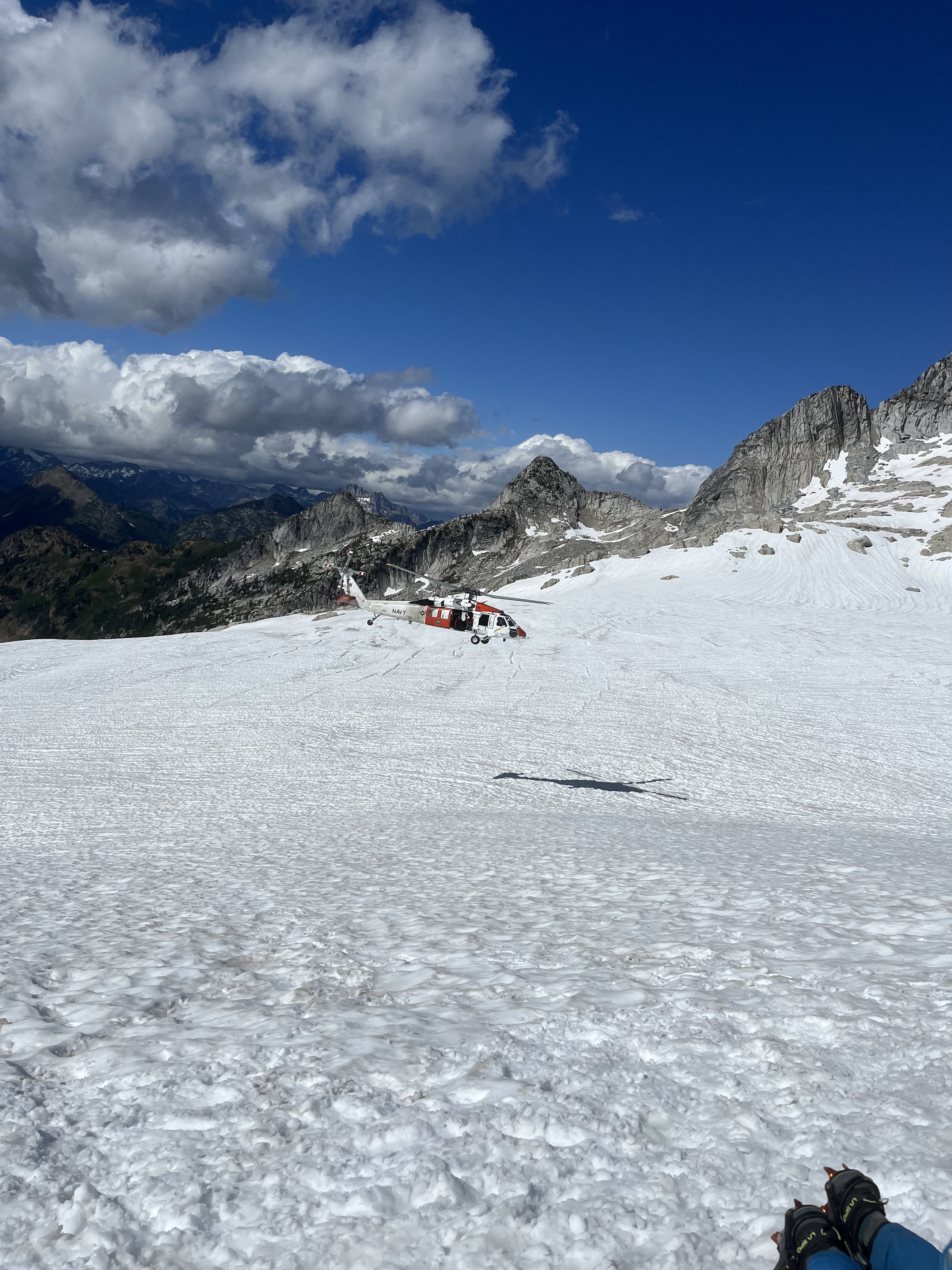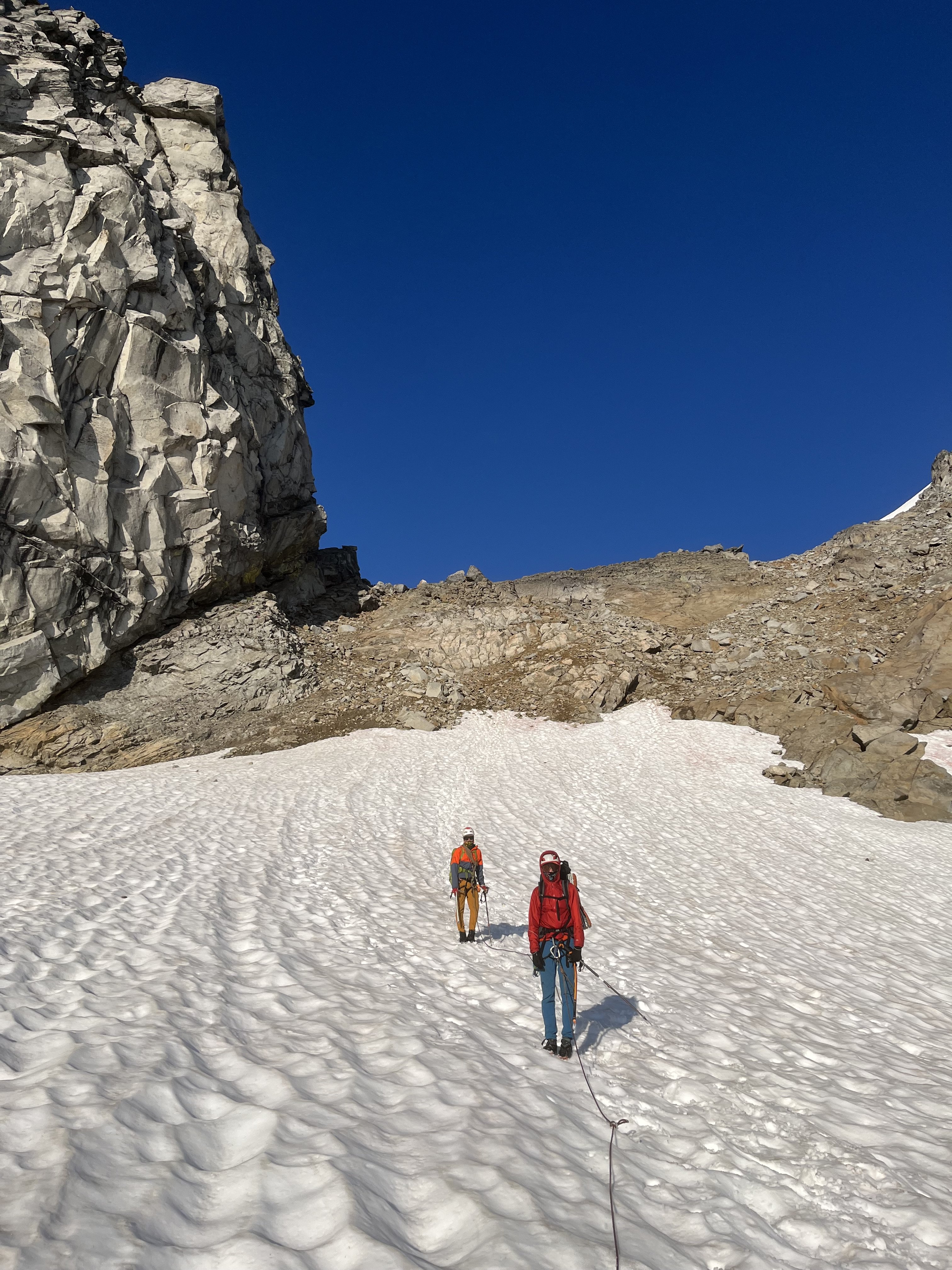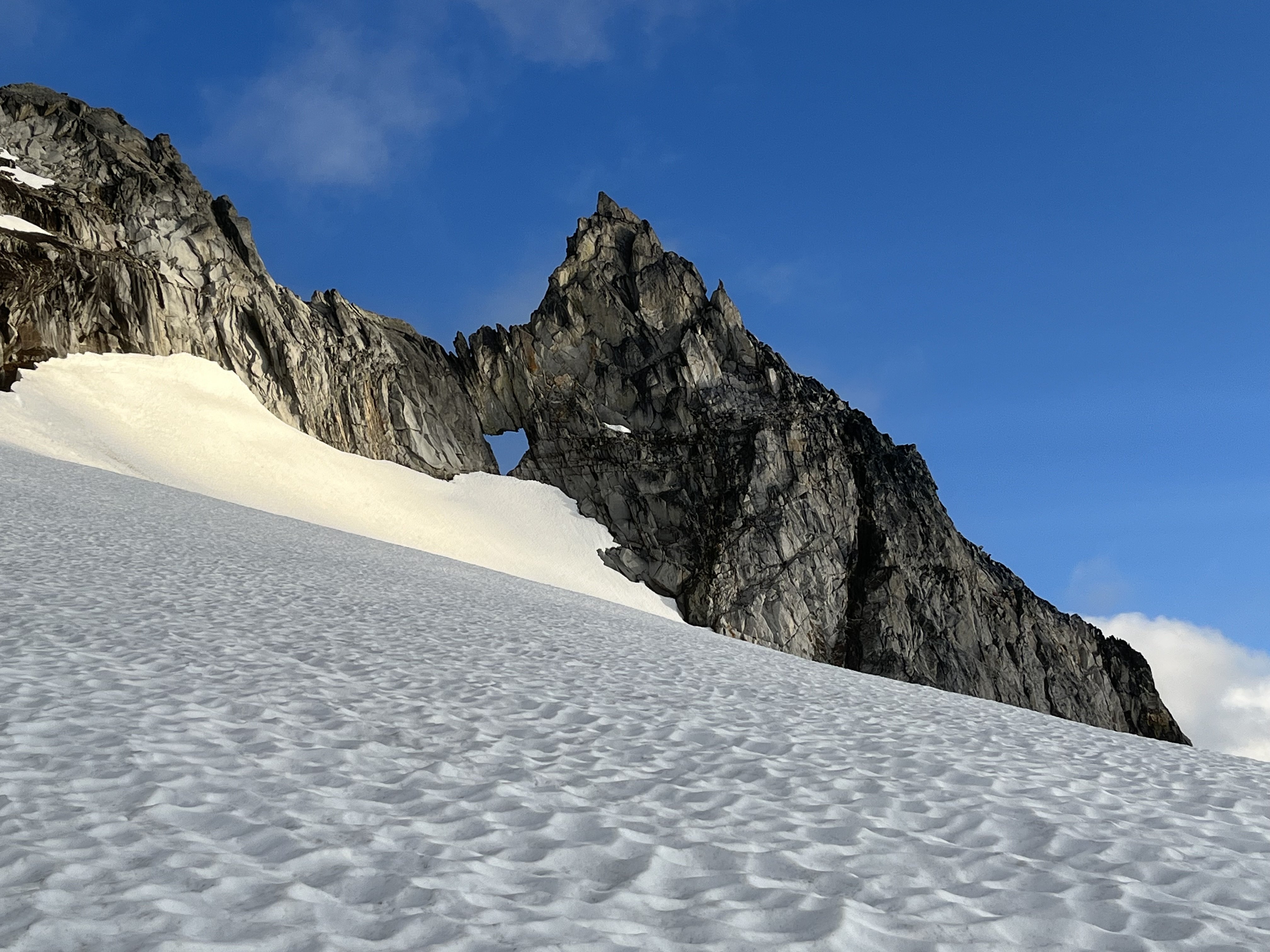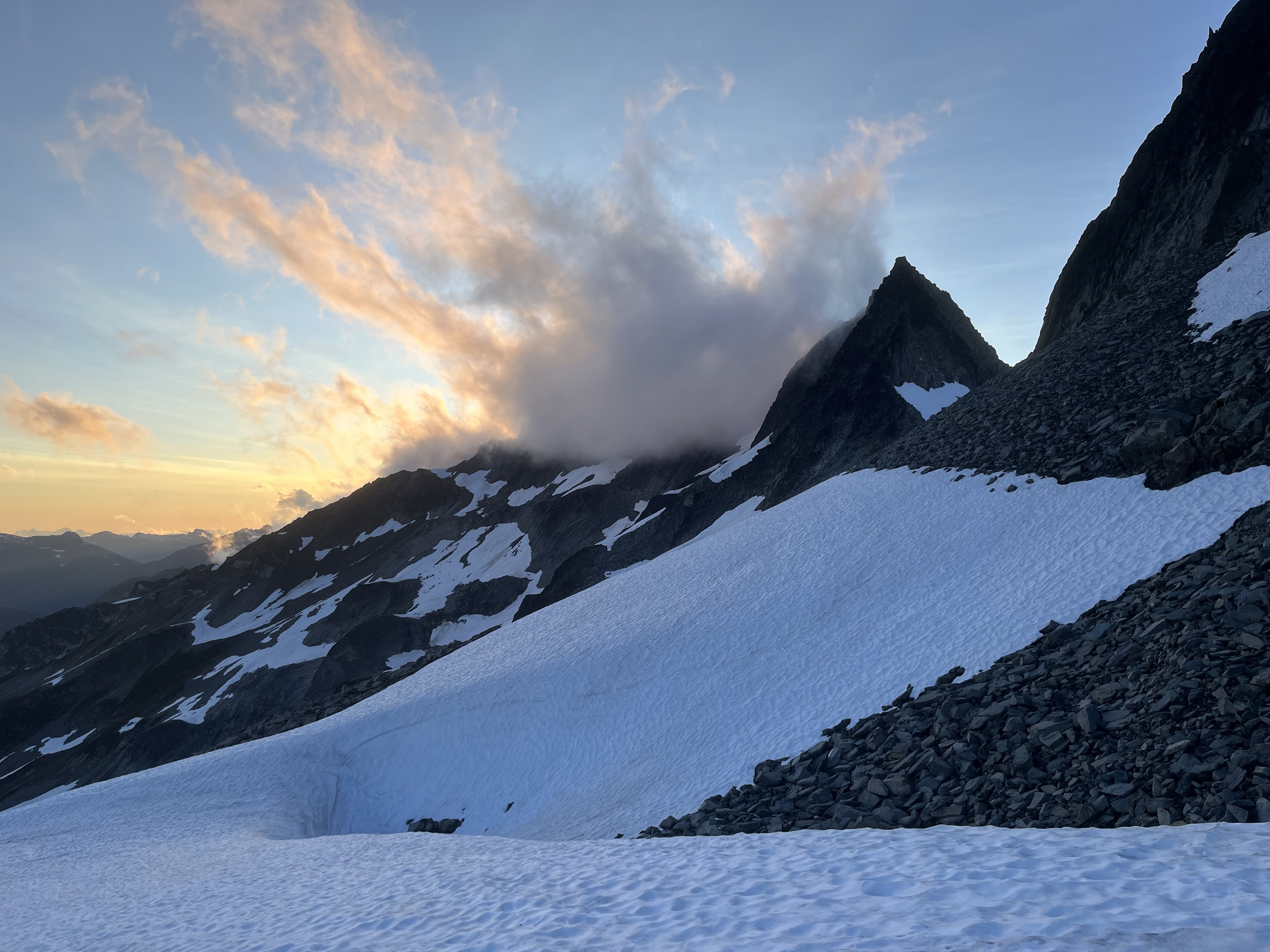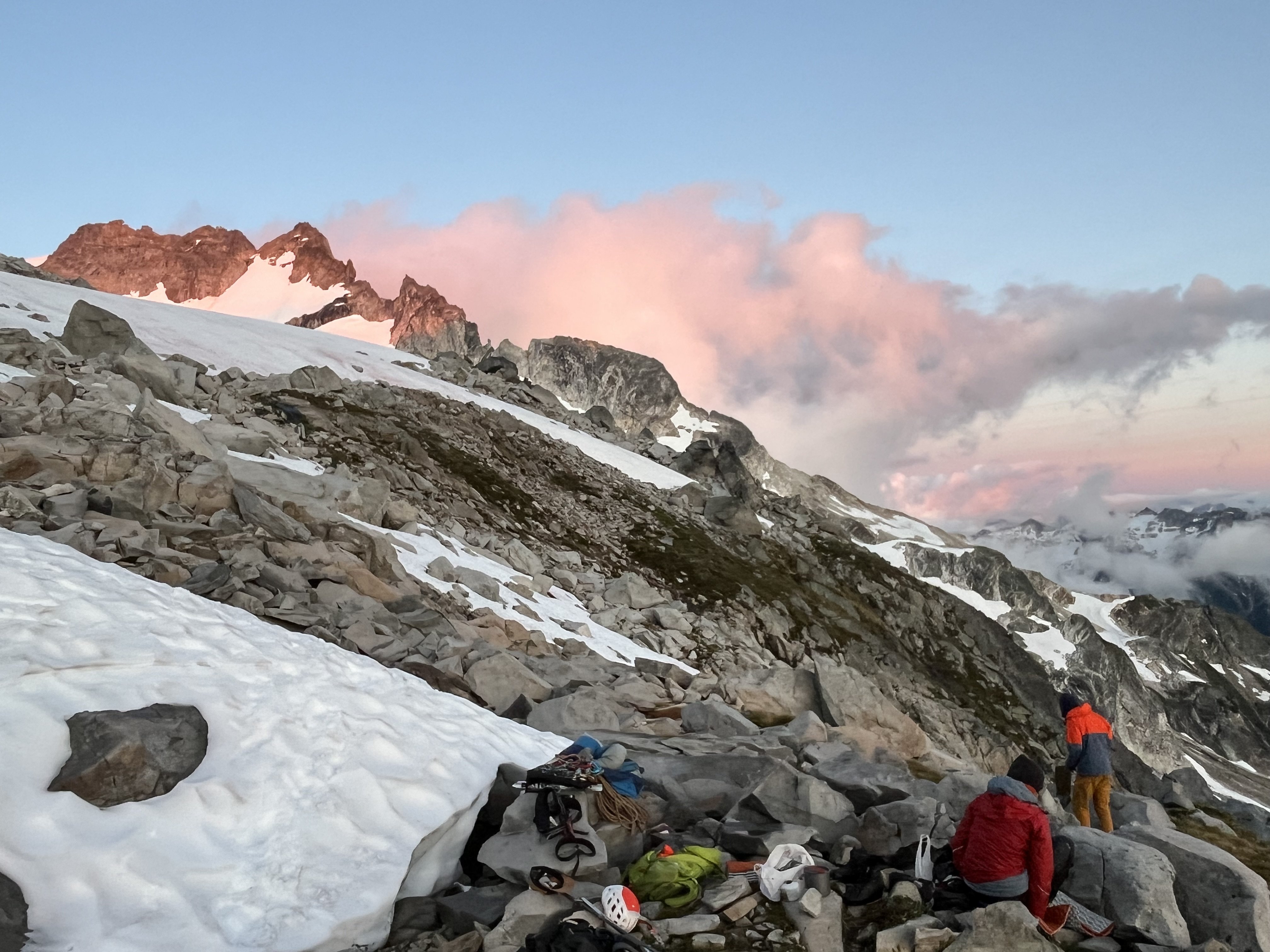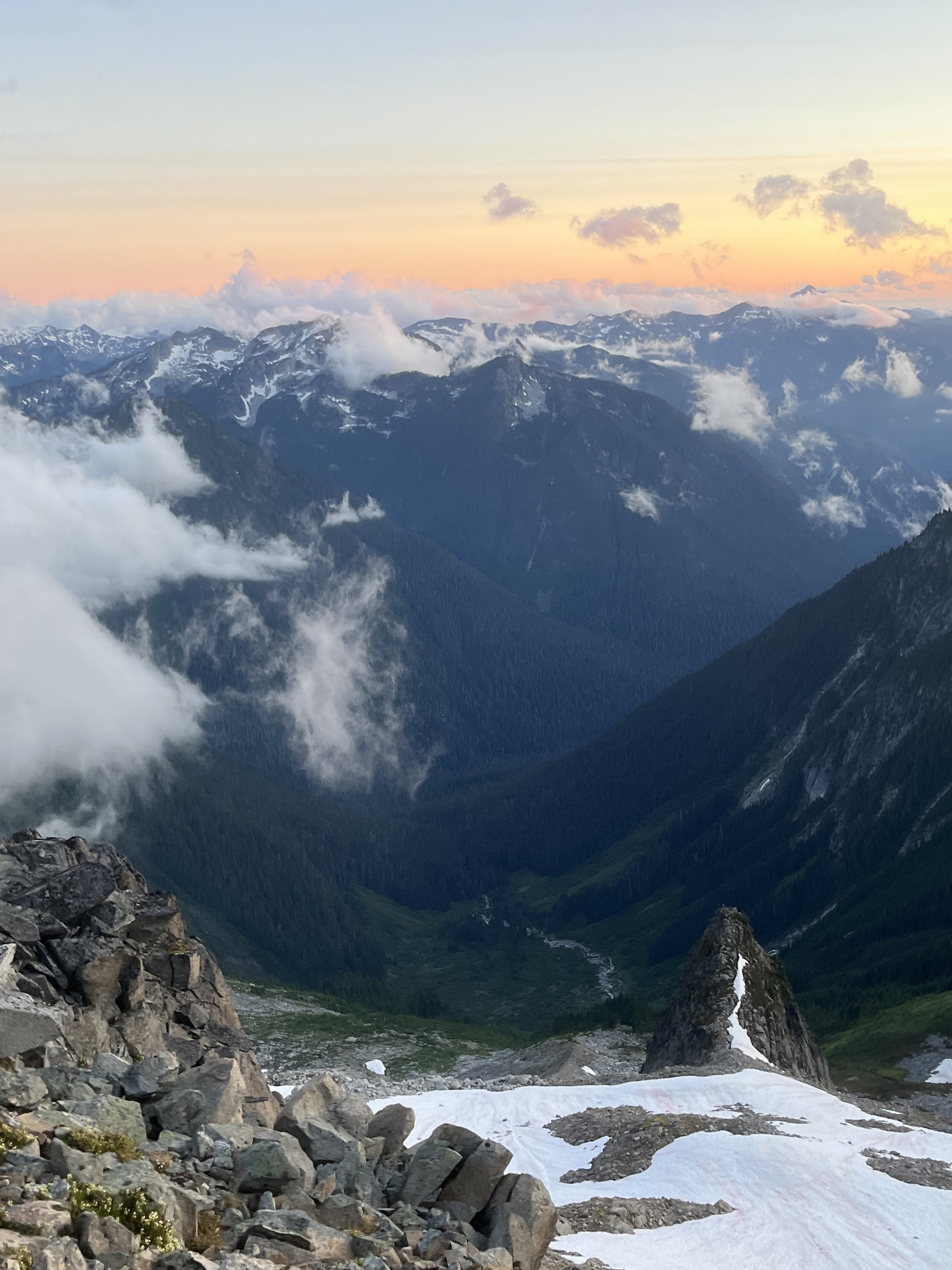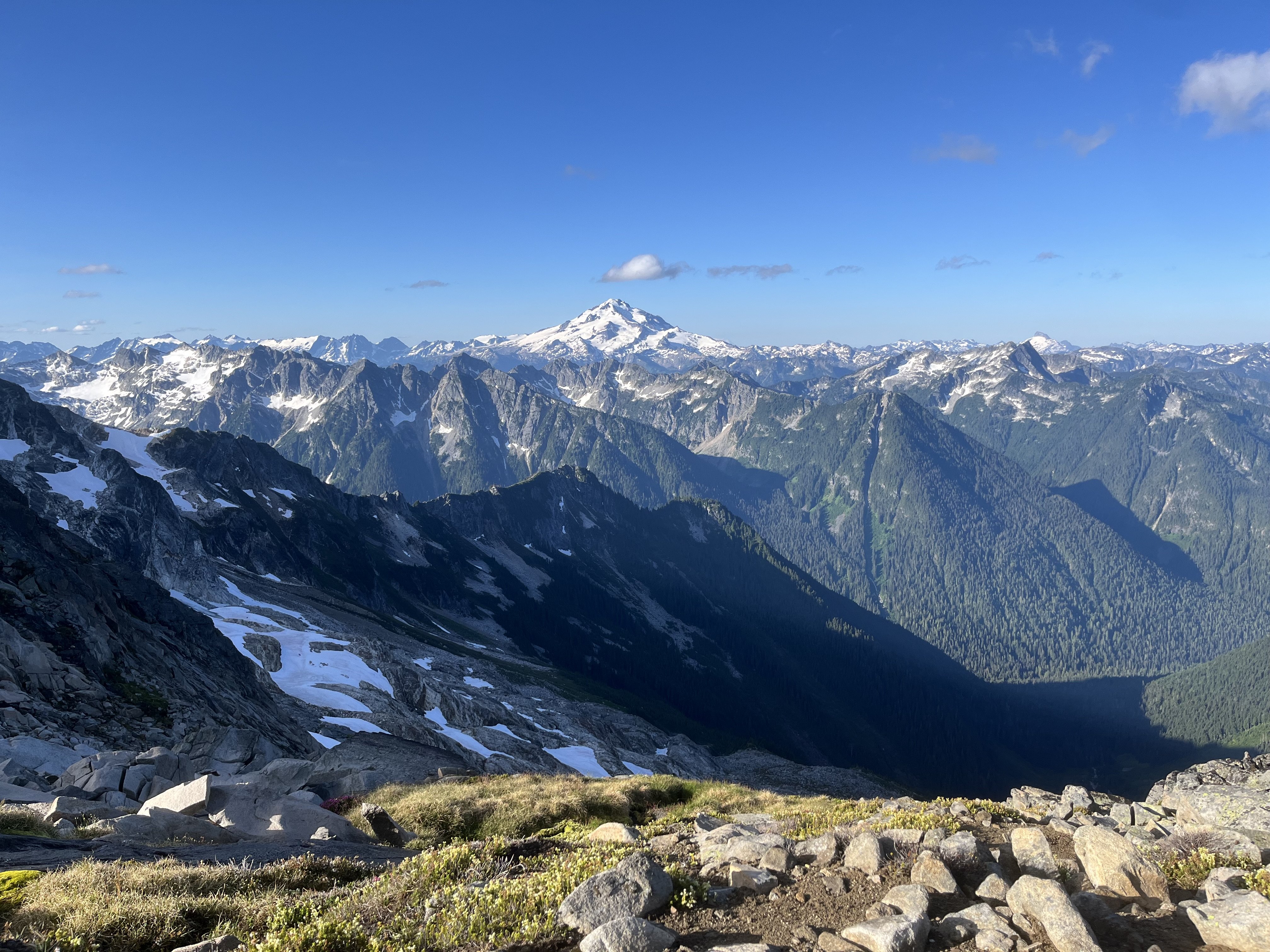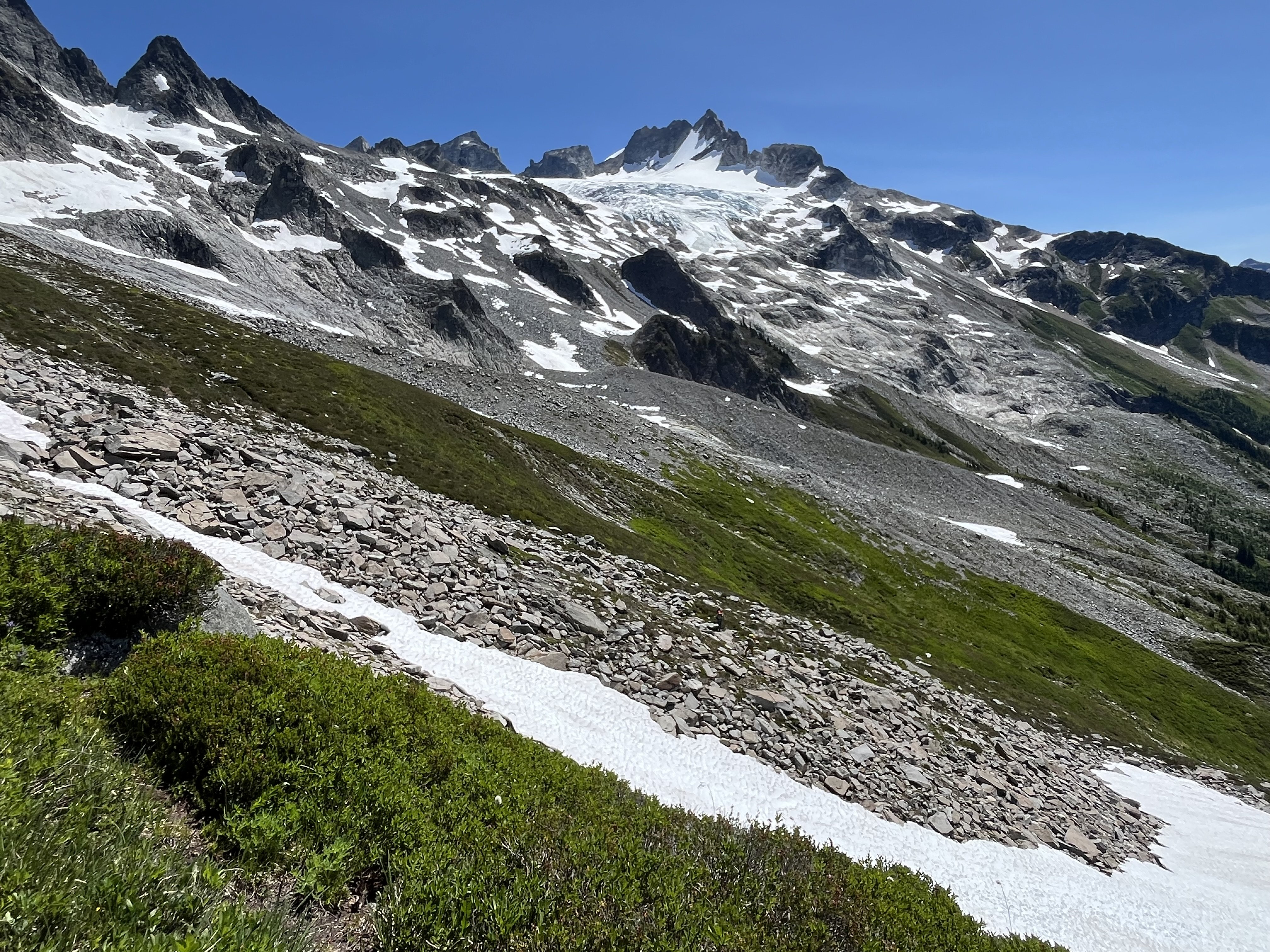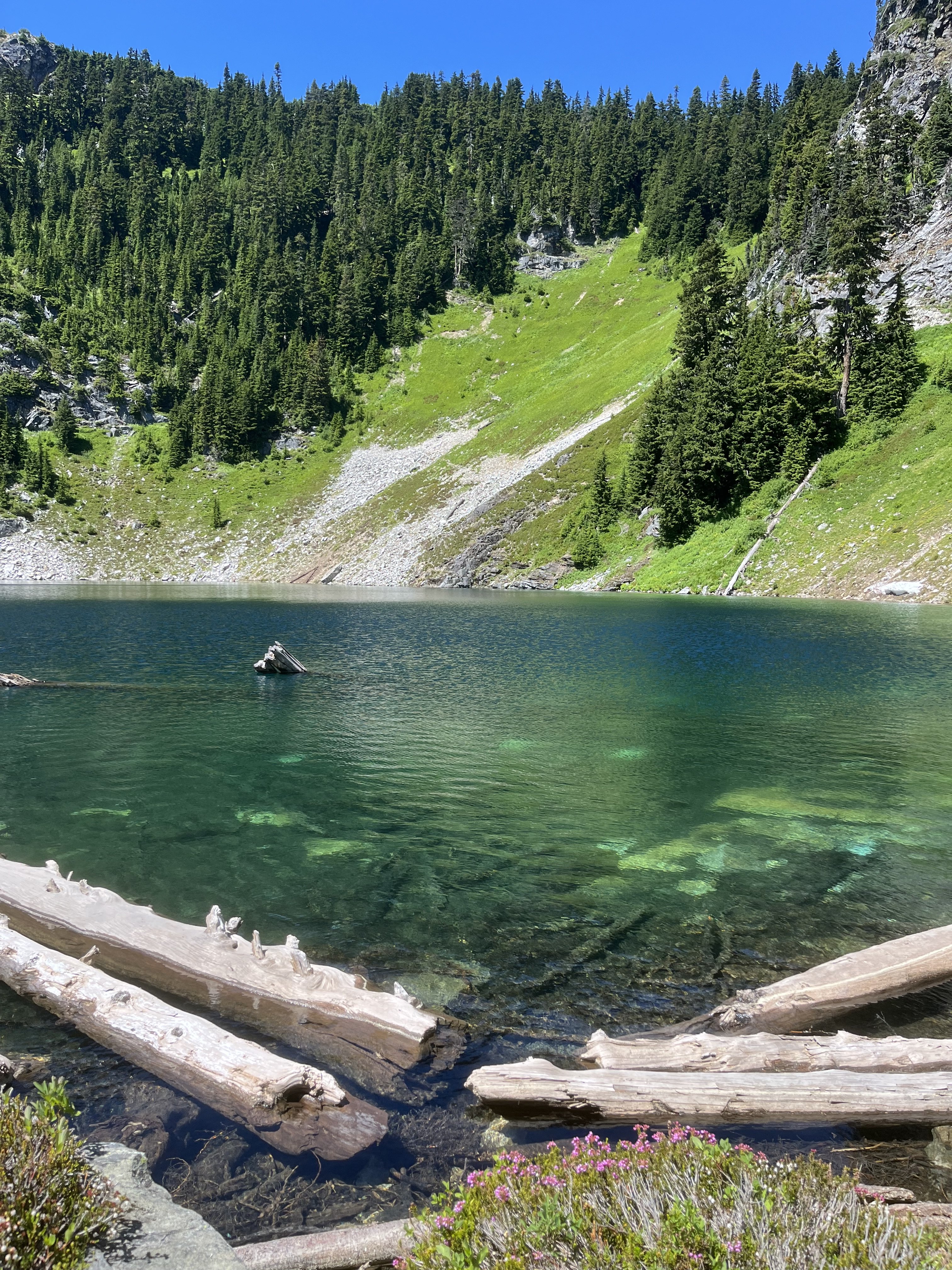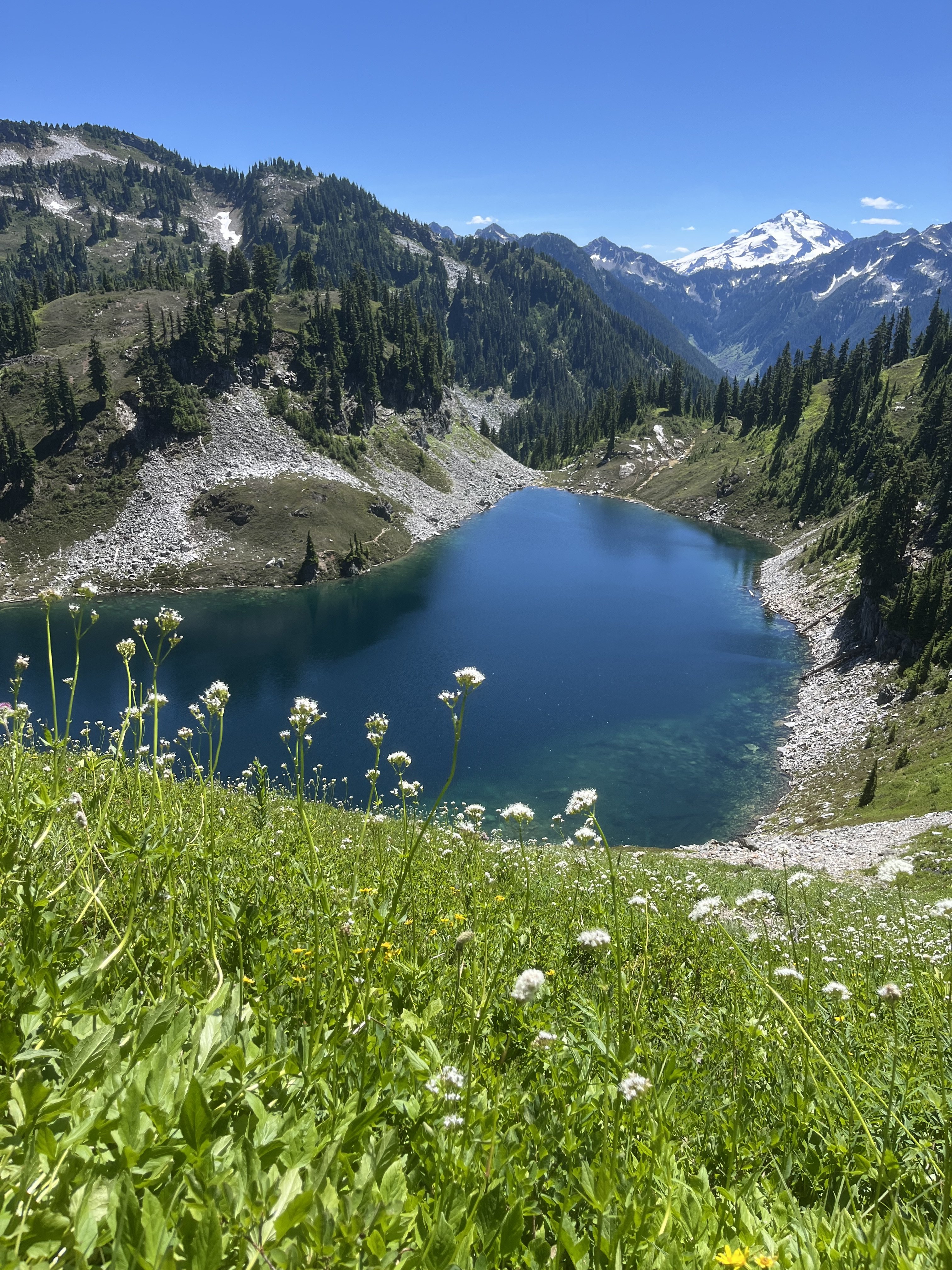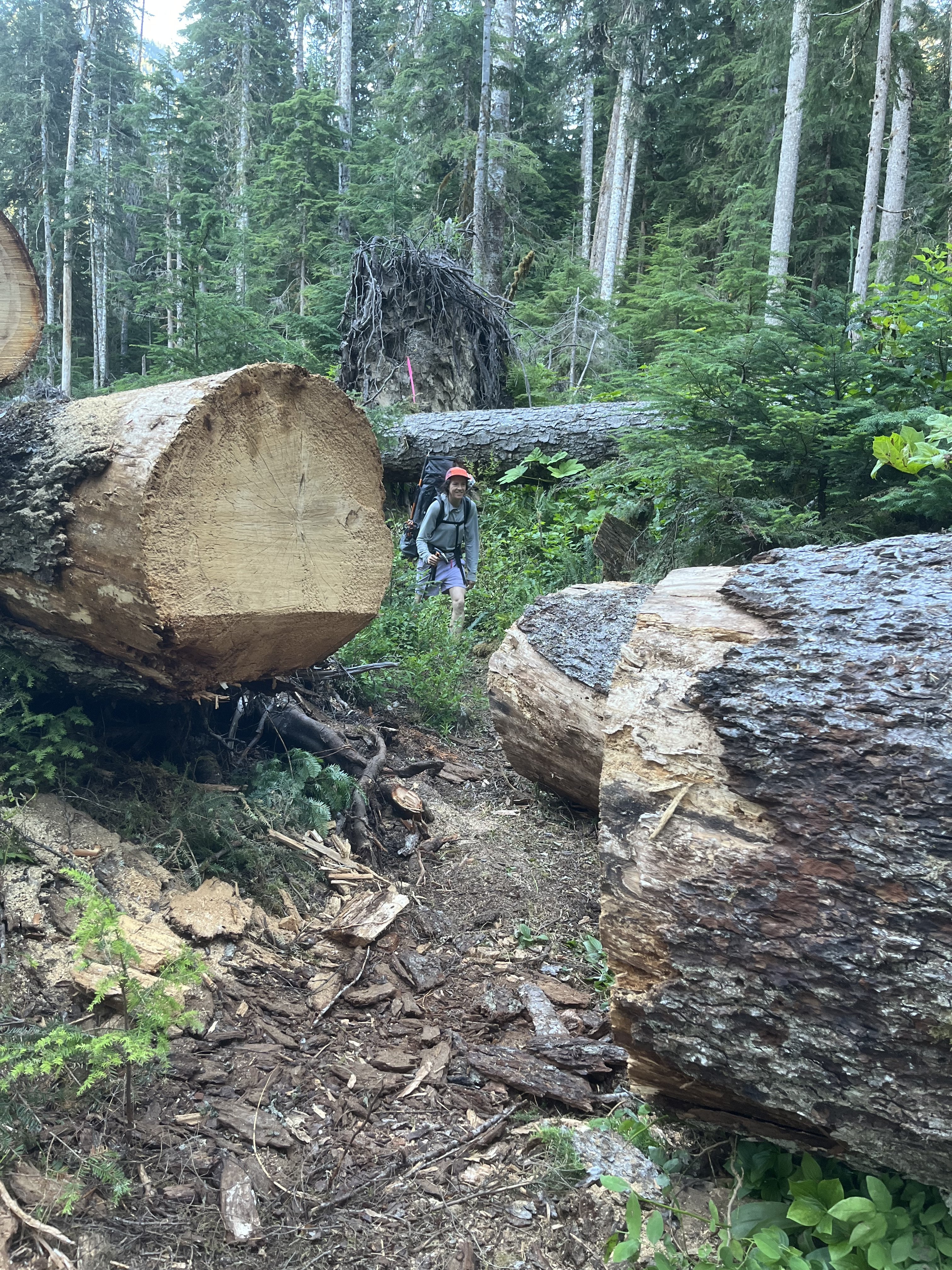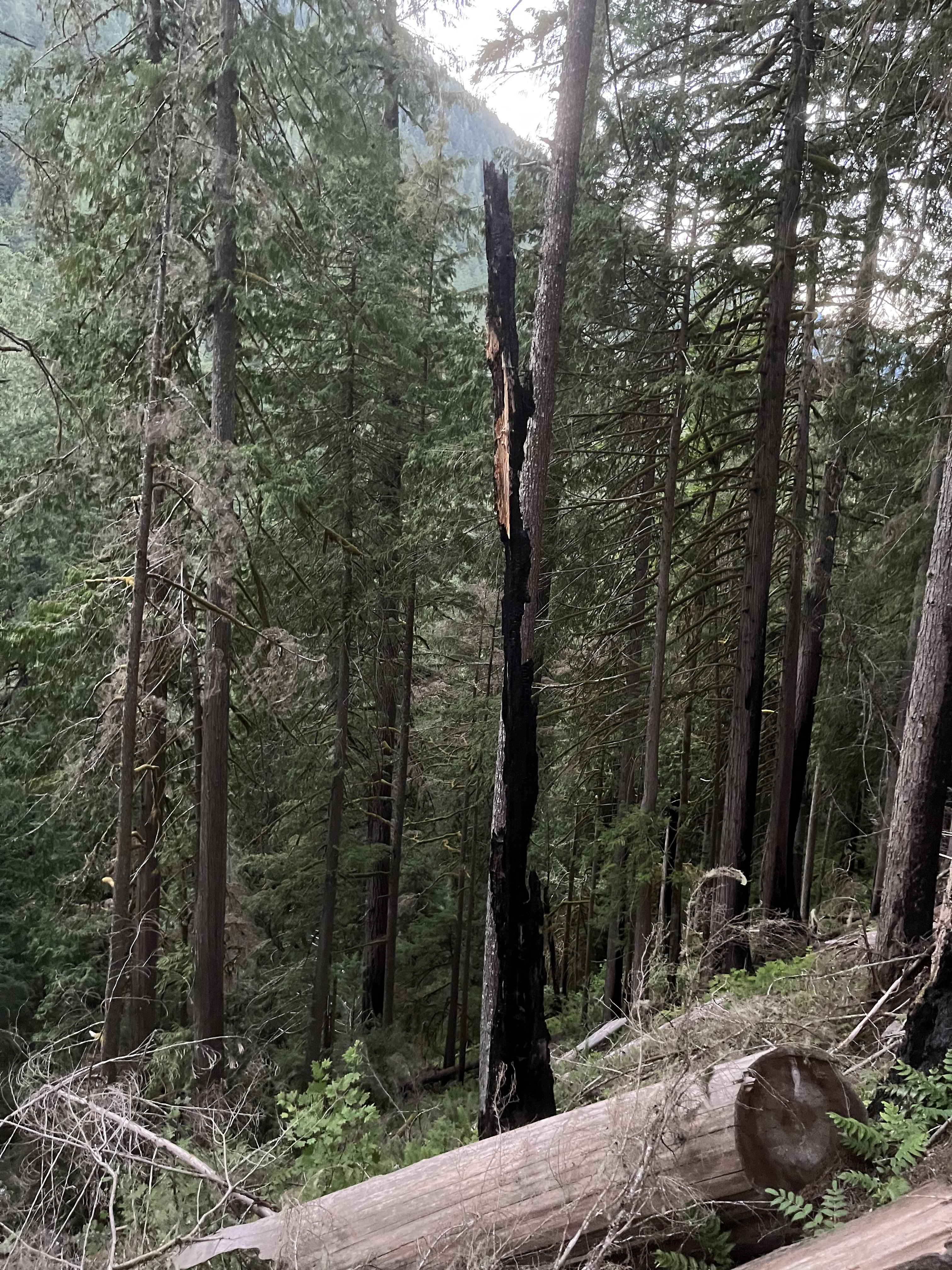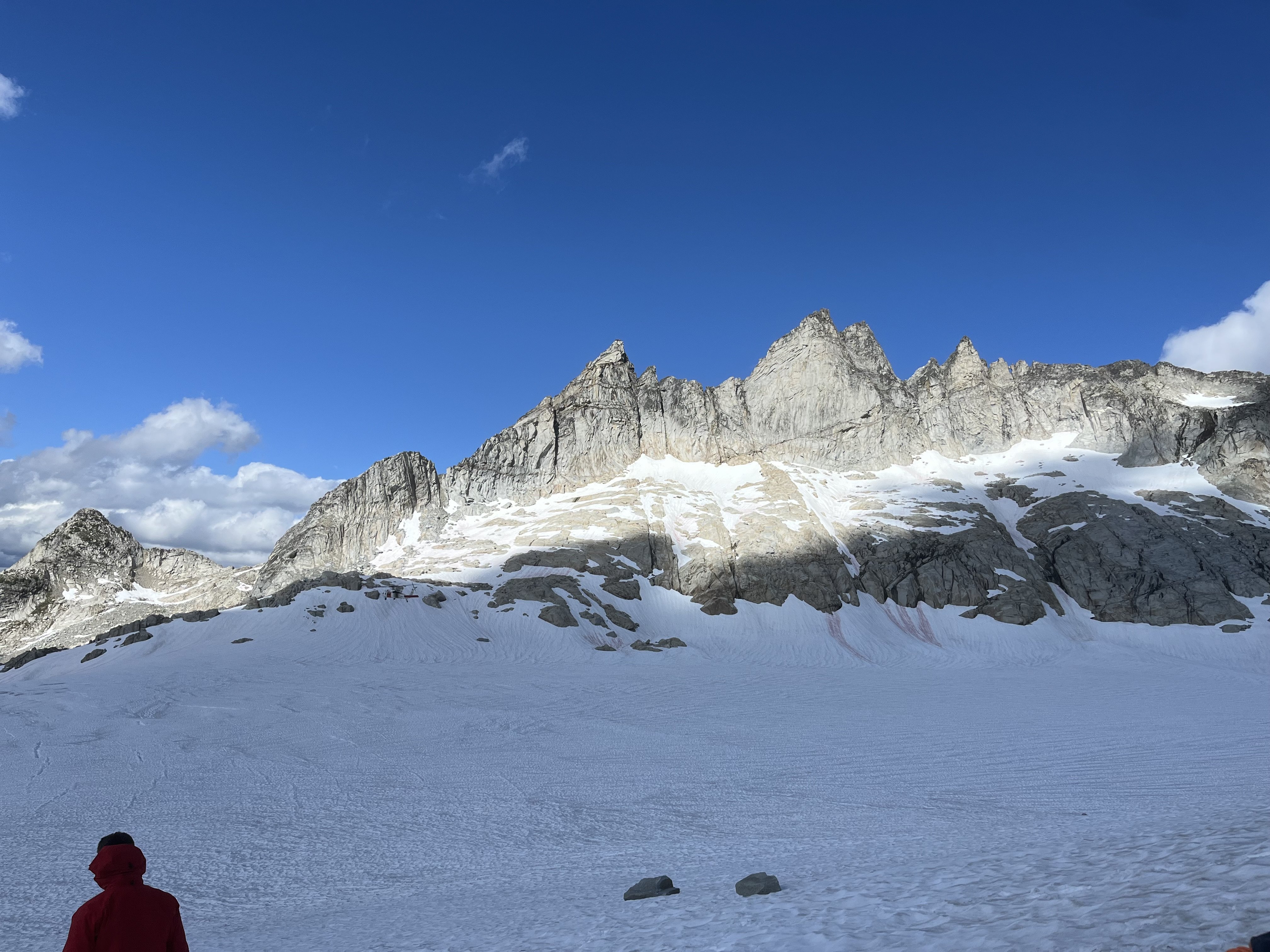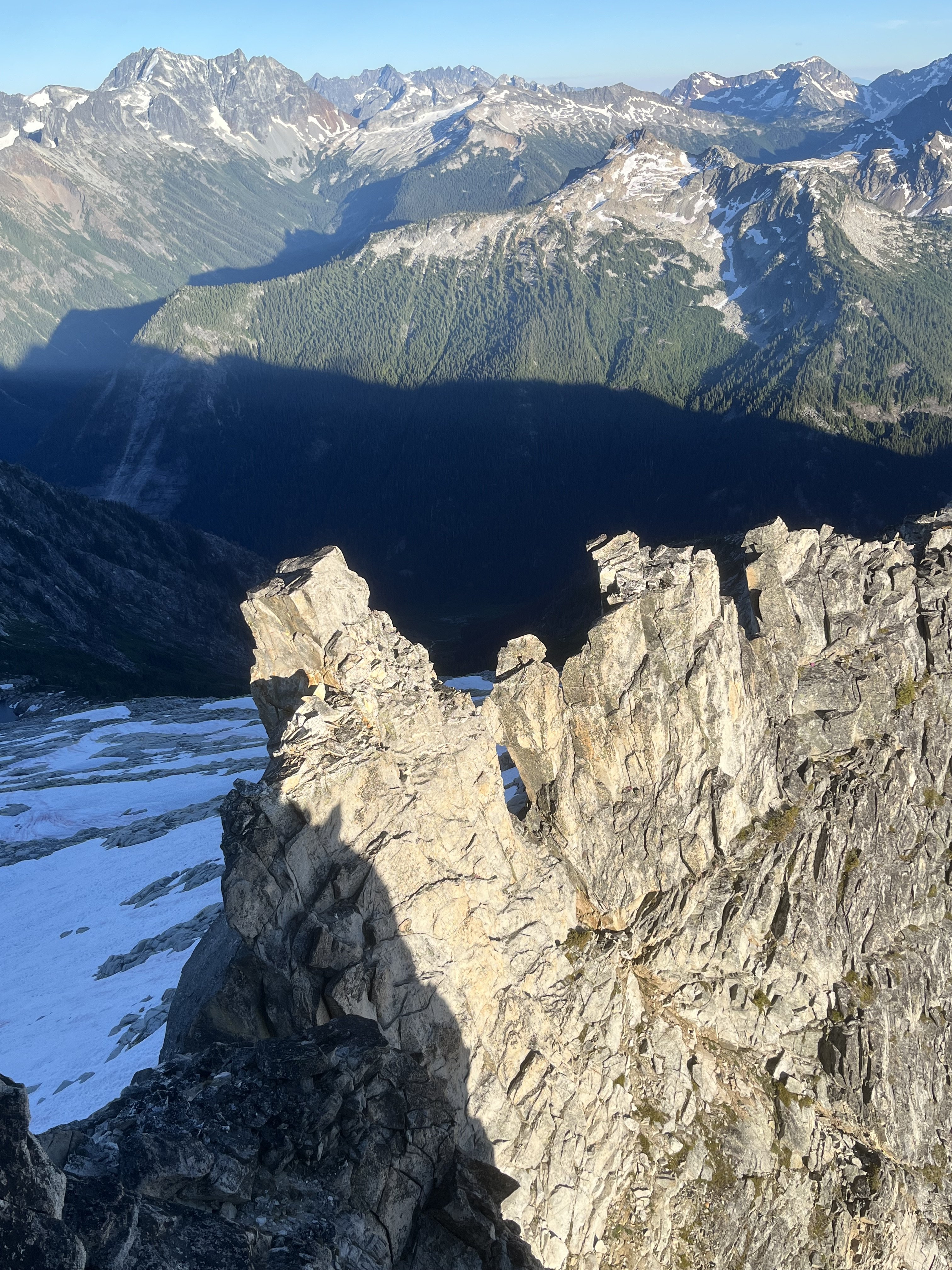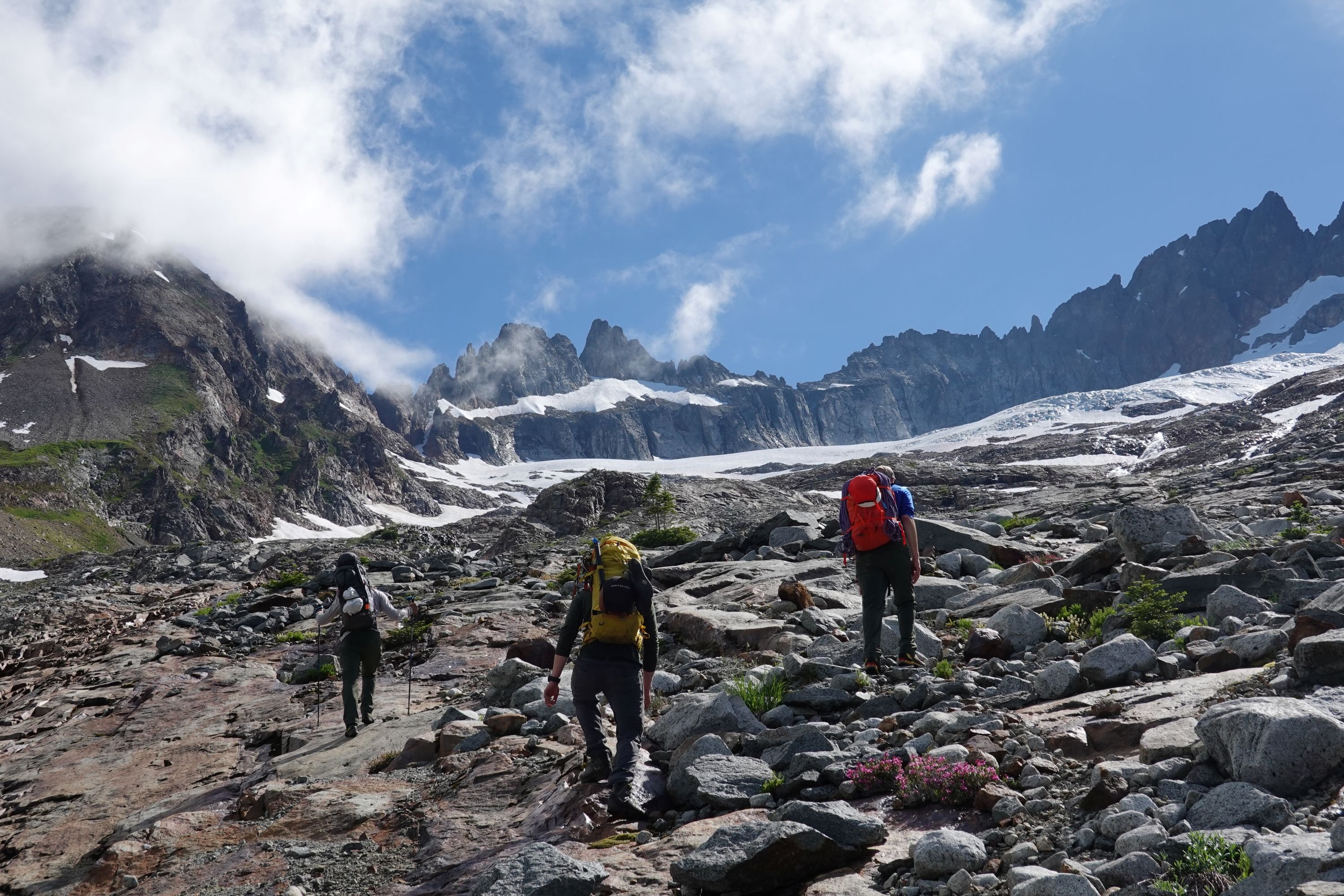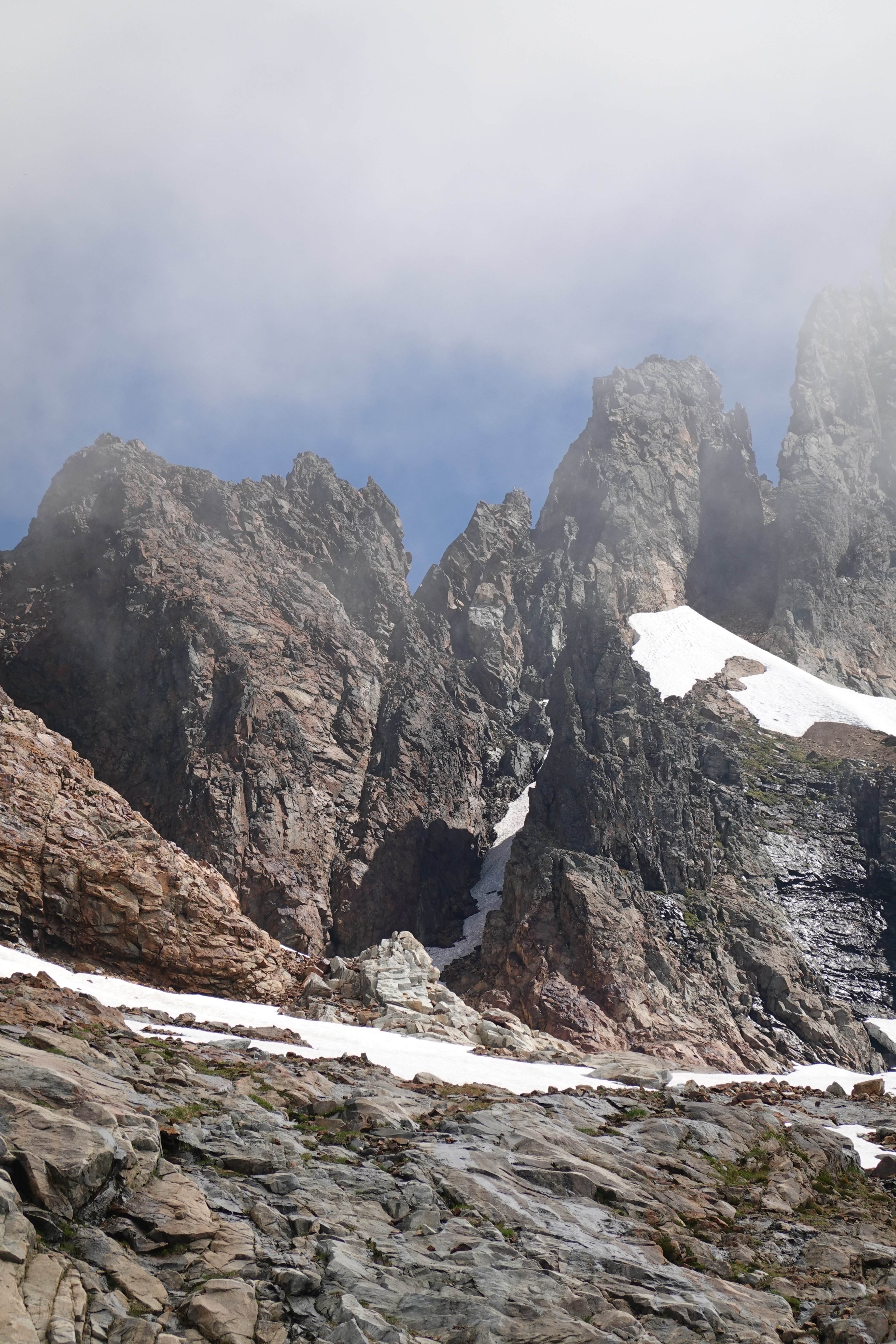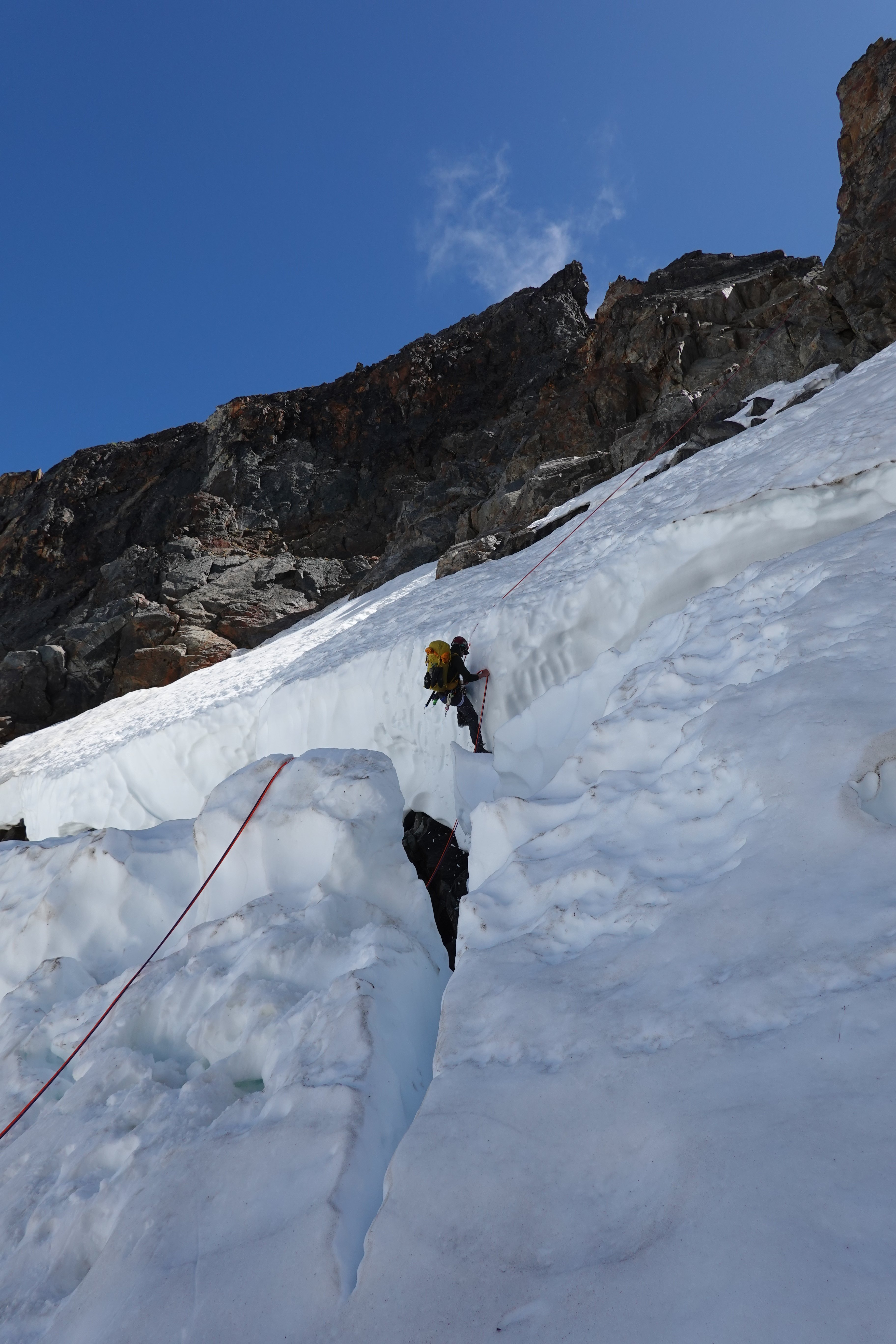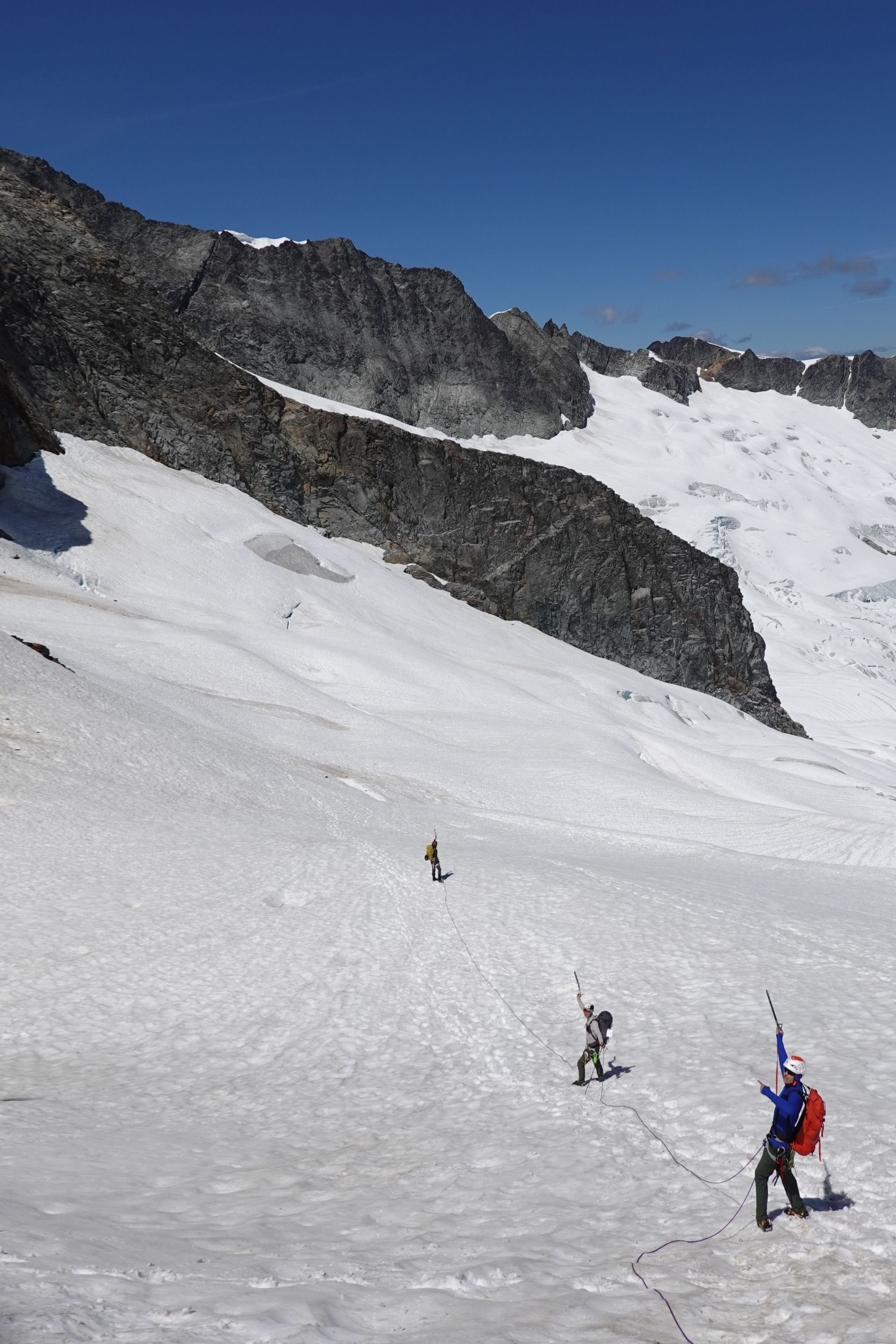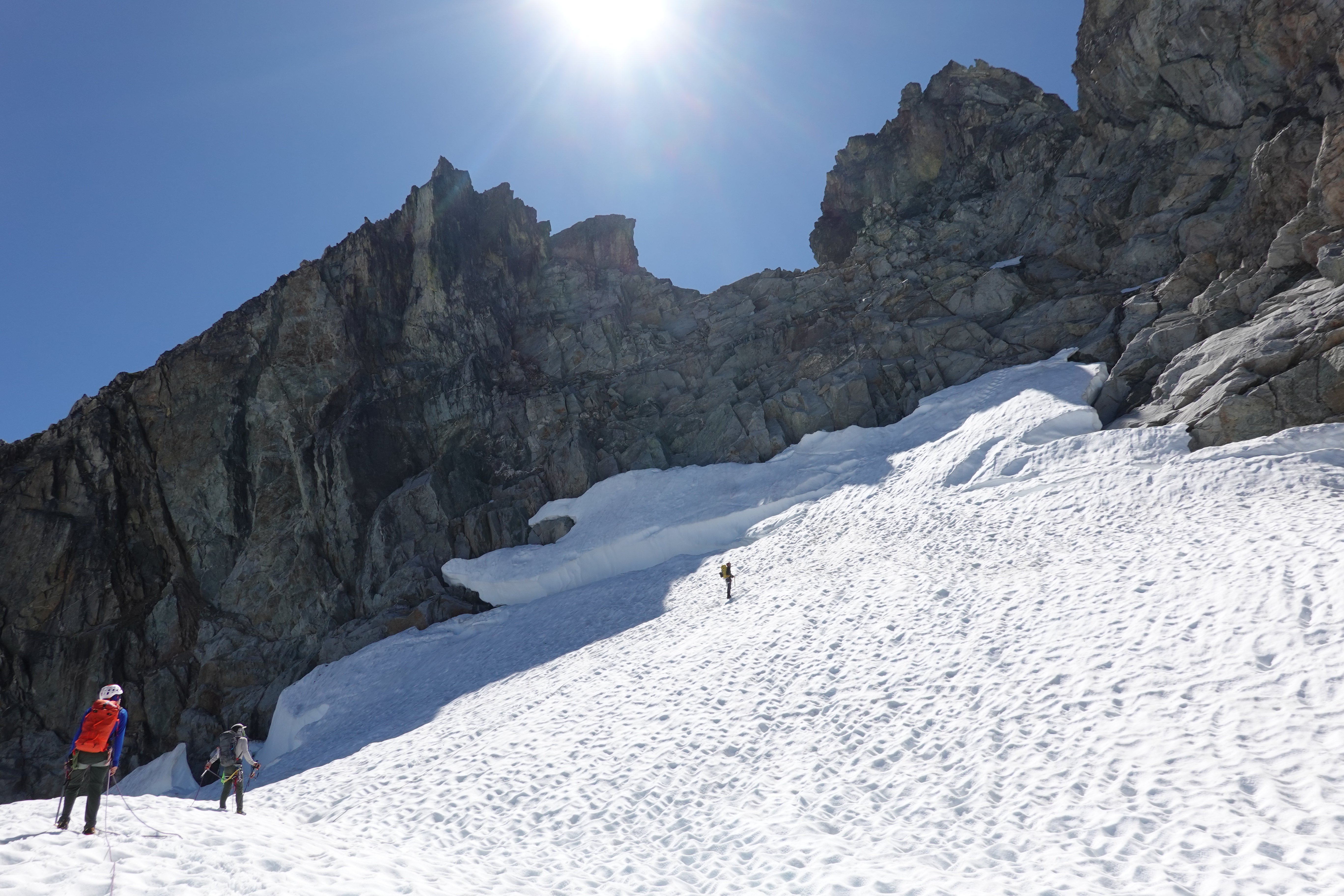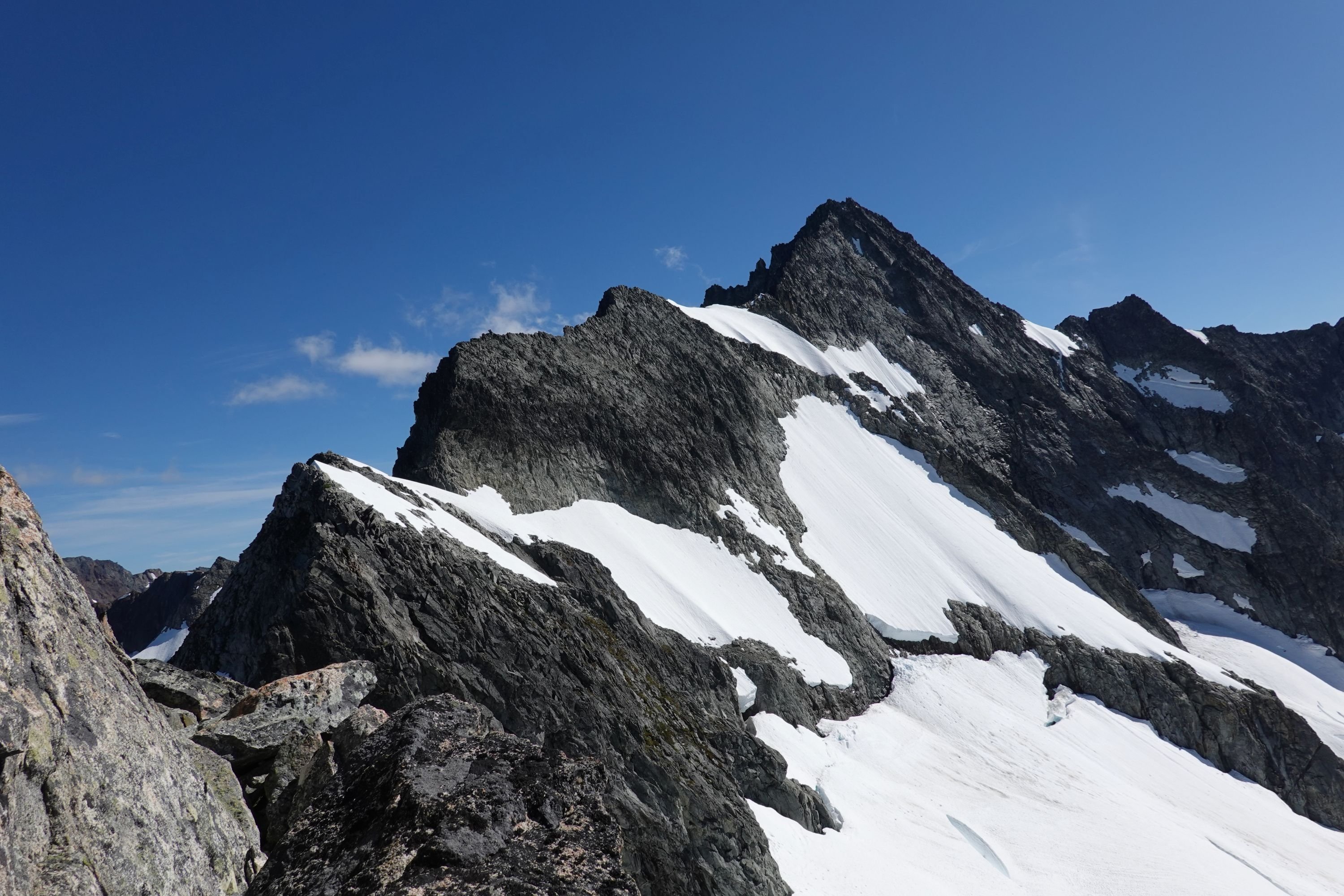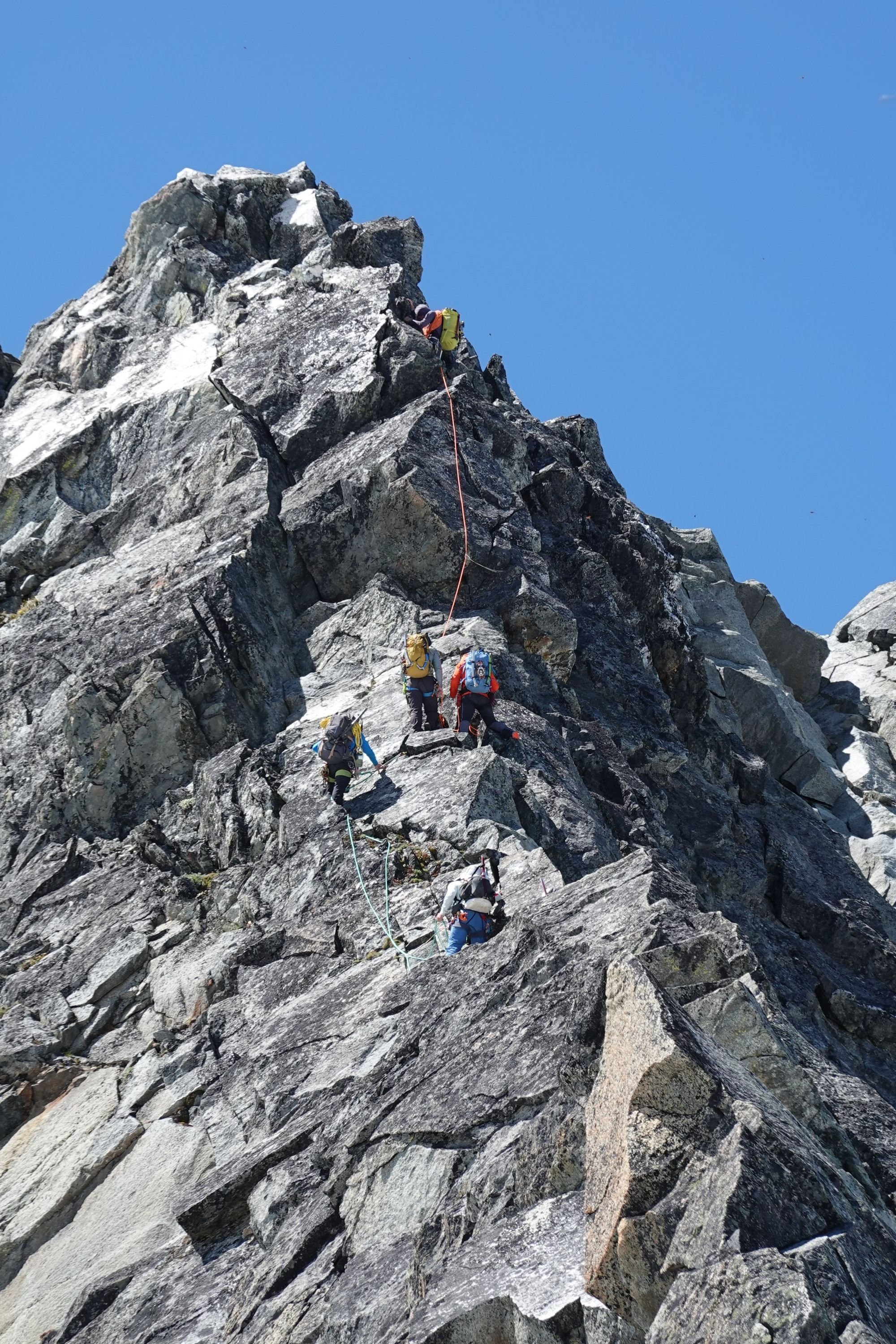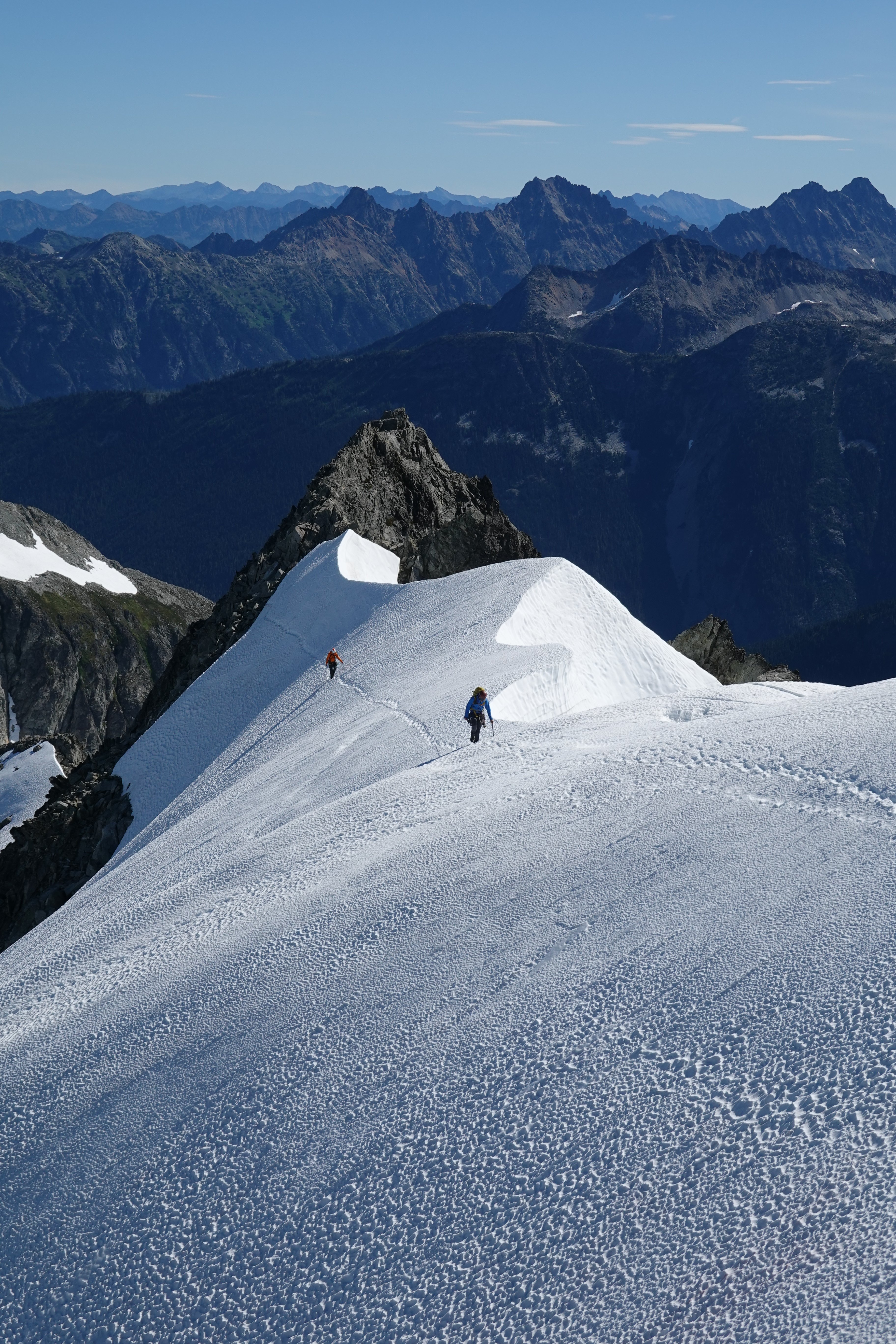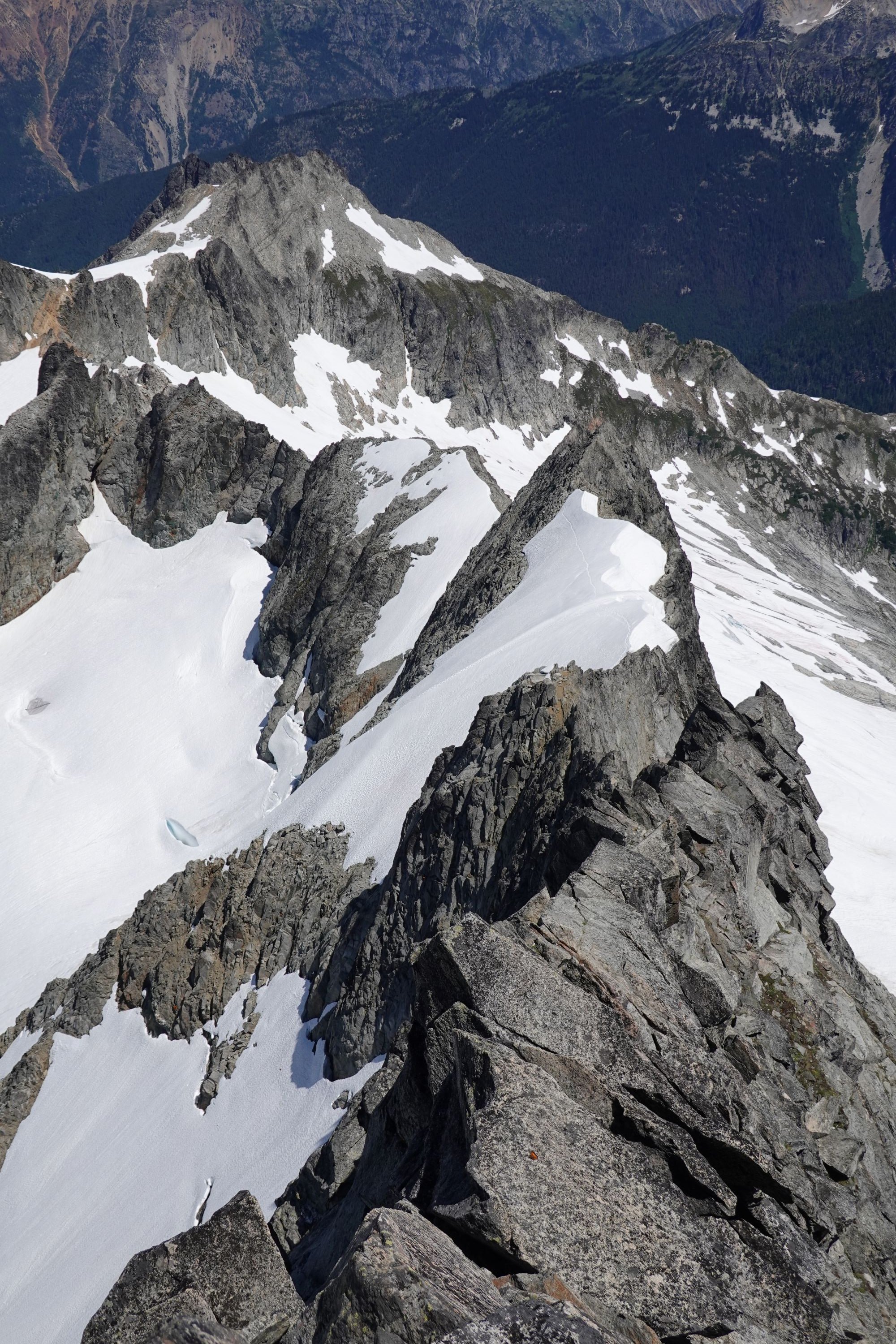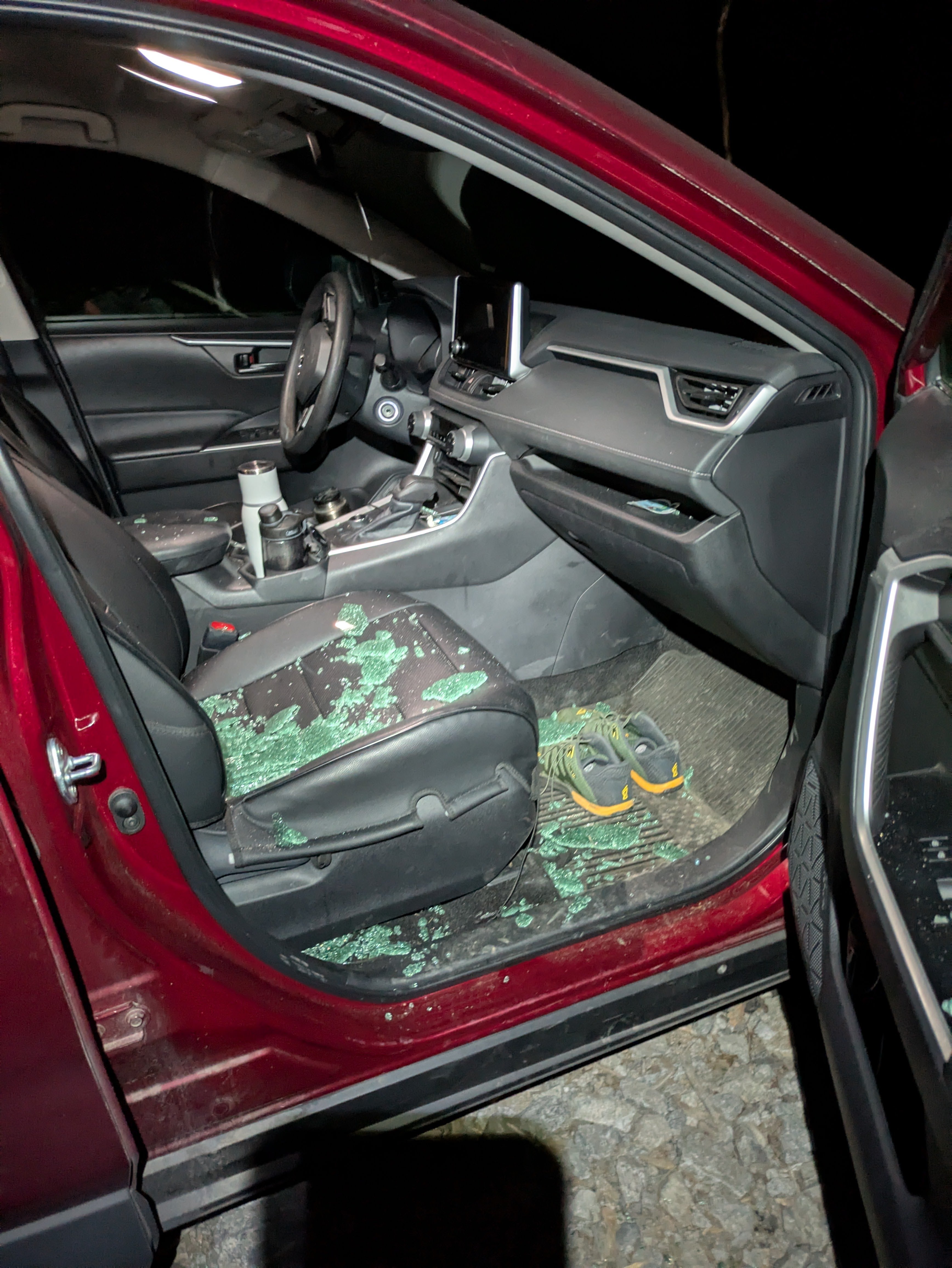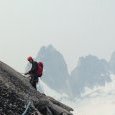Leaderboard
Popular Content
Showing content with the highest reputation on 07/16/25 in all areas
-
Trip: Forbidden Peak - NW Face Trip Date: 07/13/2025-07/14/2025 Trip Report: This has been on my list for a while given the high praise in guidebooks. Checking rec.gov on Monday, somehow permits to Boston Basin were available for this Sun-Mon that Alex, Liza, and I had saved for this route. With Liza and my previous experience on W Ridge, we figured this would go smoothly, but as is tradition with Forbidden, we were a bit slower than expected. Day 1: Approach to bivy on base of NW Face We left the Boston Basin trailhead at 8:45 am. The trail was brushy as usual and the river crossings had easy rocks to hop over. After a bathroom break at the lower boston we made our way to Sharkfin Col. We shot up a snow finger arching right towards Sharkfin and scrambled up and left in a gully about 200 feet before the big notch at the end of the snow finger. Two raps down to Boston Glacier over/in and out of the two bergschrunds. We made quick work of the Boston Glacier (thanks to some faint tracks likely from the day before) and scrambled the classic “potato chip” gully/col up to the Forbidden Glacier. With the crumbling rock/sand combination, this required the full body tension of precarious slab climbing with the added bonus of explosive holds that kept things spicy. Walking down the Forbidden Glacier was very chill and there were some rocks that were poking out in the middle that had water flowing over them which allowed us to fill up before crossing below the route and ascending the glacier on the other side. We saw tracks from a team that did the NW Face Var of the N Ridge (Scary!). We then navigated around crevasses on the west side of the rib to a snow ramp onto the rib at ~7,600 feet. This was smooth sailing for the most part, but the little snow finger to get onto the rock is thinning out so threw in a picket given the large bergschrund right below us to ease our nerves. The snow finger didn’t look like it would last much longer than a week or two, so additional shenanigans may be needed later in the season. By 8 pm we found a small bivy, which we adjusted to make decently comfortable for all three of us and set up camp under clear skies with views of Moraine Lake. Luckily we had no bugs or snafflehounds overnight, just very gusty wind and the occasional sound of rockfall echoing around the cirque. Day 2: Ascent and descent We woke up and made breakfast as the clouds came and went, occasionally completely surrounding us in grey. After breakfast we made a quick 4th/low 5th pitch to the base of the knife edge starting around 8 am. All of us were stiff from the day before and were grateful for the warmup. The knife edge was very fun and super chill! A short section of crumbly rock, but otherwise quite solid. Clouds rolled in and out making it hard to suss out the route above us. The crux pitch took some figuring out and I’m still not sure if I did it right. The first bit was one quick 5.8 move that was quite fun above the old piton and perfect finger-sized gear. The second bit was a weird overhanging hand/fist crack that felt burlier than I expected. I pulled up into the crack then switched to the face to make use of some great footholds. The chimney pitch was quite loose, with multiple death blocks that I stepped on to avoid the crumbly rock-sand. I did not enjoy leading that…. After the chimney pitch it was fun ridge romping up cleaner rock. I was a bit gassed so I handed the lead to Liza. Luckily the clouds cleared and we had some fun sunny climbing. Liza made the mistake of shooting left onto the face rather than staying on the true ridgeline once the ridgeline got more licheny. This led to harder climbing on what looked like cleaner rock, but it had minimal protection and hid multiple death blocks that threatened a scary rope-cutting incident. She shot back over to the ridgeline on the right for more fun and cleaner rock climbing to the summit by 4 pm. No major mistakes happened, but we were way slower than expected with the fatigue, weather, and figuring out our simul dynamic with this trio. We ended pitching out more than we needed to. At this point the clouds started rolling in, so we decided to high tail out. As we began the rappels along the ridge, the wind picked up and it started to rain. This was probably the low point of the day as sideways rain blasted us along the knife edge rappels. After two raps along the ridge, we did two raps down the west side to an easy 4th class ramp that meets the first ⅓ of the W Ridge. We added some tat to some of the weathered stations. Four double raps down the Cat Scratch and we were out hiking! It was great knowing the descent beta from when we did the W Ridge four years ago. Luckily it was still light when we navigated the snow field and slabs below. We got back to the car by 11 pm. Overall: This was an engaging adventure that required a bit of everything. Knowing the W Ridge descent was very helpful. The climbing was not as good as we expected, but the knife edge and some of the upper ridge were a blast. The position, line itself, and the approach are amazing. 4 star line with 2 star climbing (though with more traffic/trundling could be 3-4 star climbing). Overall, an engaging experience, but we are still quite confused as to why this route isn’t called NW Rib because the only time we were climbing what I would call a “face” we were definitely off route… Heading up the snow finger towards Sharkfin (rap we used is just to the left, rather than up in the notch straight ahead): Chossy scramble up to Forbidden Glacier: Snow finger to access the base of the route: Looking down on the the snow finger and the bergshrund below it: Morning at the bivy spot: Looking back down the knife edge: Cruxing: Alex pulling the weird crux move: Liza following the crux: Solid exposure! Summit selfie: W Ridge descent: Gear Notes: Singles 0.2-2 with doubles 0.4-1. 1 picket. Axes. Crampons. Having another 0.3 would have been nice. Approach Notes: Boston glacier approach4 points
-
Trip: Gunsight - E and SW faces of Middle, S ridge of South Trip Date: 07/13/2025 Trip Report: I had the tremendous luck of finding a pair of climbers (Rebecca and Shane) who wanted to check out the Gunsight range using a rope team larger than 2 for the Chikamin. We climbed as a party of 3. They turned out to be excellent climbers and excellent company. First I’ll stick mostly to the things I wish I knew beforehand, inaccurate beta, etc. On our second day we blindly followed tracks of a party about a half hour ahead of us in the Chikamin which led to the lowest pass. Getting on the rock it seemed like possibly low 5th slab and too far south of Gunsight. We decided we were in the wrong place. I briefly scoped the next gully north which was terrible. We then found the right path, using mostly clean slabs. In Blake’s book the arrow isn’t quite in the right place, we were one notch north of his line, in the “s” in “peaks”. We had hoped to climb E face of Middle this day but with the lost time settled on S ridge of S peak. We would later find out that doing E face of Middle on day 2 is doable only if everything goes right, no route finding issues, climbing and descending efficiently. A better plan that I’d recommend to most coming from Downey is to aim for SW face of Middle for your day 2. P2 and start of P3 on S ridge S Gunsight: S ridge of S Gunsight is a garbage climb. The first pitch is not terrible but the face after an ok corner is covered in black lichen and any pro seemed worthless. Hard to find an anchor on top of the choss ridge. Much less than the reported 45m. The next very short pitch, again much shorter than in our description, has an exciting knife edge lean + leap onto the rock that begins the cannon hole (my first trad dyno I think). From there we expected 5.4 to finish the climb. I went back and forth, high and low, repeatedly dead ending near a notch with lots of tat. Finally I committed to a delicate and highly exposed 5.8-5.9 stem around a corner to get to a downclimb to the notch. From there I ran the rope out to the summit at somewhat dirty low 5th. Looking back I saw how the follower would be exposed to a big pendulum and deck, so I encouraged my partners to just rap that step off the existing tat. With a couple raps we were back on the east side retracing our steps to the notch. Numerous steep hard snow interruptions to the slabs involved time sucking crampon on-off transitions. I was grumpy about 2 days of effort to climb 3 pitches of choss but we caught a gorgeous sunset just as we reached the notch. From there we traversed high on snow and slabs below Gunsight to get to where we had stashed our bivies. The next day we tried again for E face of Middle. Rather than circle around the peak again Rebecca had the great idea of climbing the SW Beckey route, rapping S to the notch, then rapping E to get to the E face. The Beckey route was straightforward low-mid 5th choose your own adventure on fun solid rock with lots of knobs, which we began from a small cave just above the best moat crossing we found. The summit register’s last entry was from 3 years prior, a party doing gunrunner. We did one rap south beginning a little below the summit, backing up the slightly suspect block. From there a double rope rap from a higher confidence anchor got us to the notch. The anchor we found there wasn’t very great but we couldn’t find better options. I immediately found the e side to be mostly steep dirt. Angling slightly south I found an ok nut anchor maybe 45m down from the notch. A double rope rap from there got us down to the very dirty snow. This might have been the dirtiest gully I’ve descended up to that point. The high quality of the E face lived up to the hype, though misleading beta vexed us at times. Our first pitch was quite long due to low snow and glacial recession. Comparing our photos to some from 15 years ago there was some thing like 50-100 feet of rusty rock that had been covered in snow in the earlier photos. The pitch 2 crux is right off the deck and maybe sandbagged (or I was just tired). Awkward, tricky, exposed to decking, it took me about 4 tries to lead through it. I don’t think the pitch was more than 15m. This was another ledge where a good anchor was hard to find. Pitch3 (10c) was actually easier than pitch2. Shane had stopped one ledge short of the proper start of pitch 4. We worried about linking that step into pitch 4 because it’s supposedly 45m. In reality pitch4 turned out to be more like 30m. Oh well. The pitch 4 climbing was fantastic and its crux (10d) was another possible sandbag. I could not have led it. Very demanding powerful moves finally got me through it after a few attempts. By now the hour was late and we were looking at the mental crux of the runout 5.9 slab. Shane led this one too. Rebecca went second and I came last. I was glad to have watched them for beta on the subtle step down crux at the most run out point. Brilliant colors lit up the horizon while it was my turn but I could give it only fleeting attention as I concentrated at the crux. Once through I ran up the ridge (low 5th? Didn’t notice any 5.8) in the twilight, basically a full 60m rather than the 15m our beta advised. We repeated the rap sequence south to the notch as it grew dark windy and cold. The rope got stuck during the pull here. With much effort Shane finally freed the rope. The descent to the east was a known thing at this point but I argued that it was so bad that the descent to the west couldn’t possibly be worse. About this I turned out to be wrong. We did one short rap to an anchor south of the main gut/vomitorium of the gulley, with resident snaffles greeting us at both ends of the rap. From there Shane plunged into the unknown, over an overhang, choss diarrhea of all sizes being released. At a full 60m we went off rope and I took a clean slab ramp around a corner and found good cracks while they pulled the rope. Somehow that rap didn’t destroy us or the ropes. We placed a cam anchor and got past the steep icy snow onto lower angle stuff and began the traverse back to camp, arriving around 2am. We made dinner, celebrated, and tucked in around 3. Next morning I went back with the suspicion that our anchor could be reached on class 4 slabs that we couldn’t see well in the dark. It turned out to have a little low 5th, so rapping was definitely the right call for the circumstance. But I was glad to recoup our gear. Having encountered the worst and second worse gullies of my life on either side of middle gunsight I now think that the best way to retreat is probably down the SW Beckey route. It’s ledgey so it would be best to downclimb most of it with some raps where it makes sense. And best done in the daylight, after climbing it at least once so you know the way at least approximately. Faded from the unexpected epics our only goal for day 4 was to get back to Itswoot ridge, beginning around noon. But around 1:40 at about 7K’ we heard a voice from a distance. We stopped and listened. Heard it again. Could barely make out words like “broken ankle” “helicopter”, “alone”. We pressed the SOS. The voice seemed to be vaguely in the Sinister area but we couldn’t tell where. We started backtracking and did some Marco Polo every few minutes without success. Finally passing east of the north face of Sinister we saw what we realized was a person. He was not moving and covered in a gray sleeping bag so we hadn’t been able to tell him apart from a rock at a distance. Maintaining some privacy here, we found that he was indeed immobilized and in severe pain and needed rescue. His inspiration and his equipment were in disharmony and this had culminated in a long and presumably very rapid slide down snow NE of Sinister. Fortunately over cracks, unfortunately meeting some rock(s) along the way. A little while later a father and daughter were coming down the Chikamin. It was nice to have more help. We did our best to keep him warm and as comfortable as possible as we waited for SAR. When the helicopter came we were surprised that it took so many laps through the area (maybe 5?) before two rescuers finally were lowered down with a litter. The morning had begun mostly cloudy but the afternoon was quite brilliant. Some rain approached quickly from the north and reached us just as the helicopter took off with the victim and SAR people aboard. We restarted our ascent in the rain, reaching our turnaround point >4.5 hours after we had stopped. This guy was quite fortunate that several people happened to be in ear shot on a week day in such a remote area. The rain cleared half way up the Chikamin and gave way to that kind of really clear atmosphere that seems to come on the heels of misty alpine weather. We found a wonderful spot past Dome glacier, well before Itswoot and called it a day. The highlights of our last day included a brief swim in cub lake, the flora above cub lake, and the many berries along Downey. Less fun was stuffing our pockets full with entirely unnecessary flagging all along very obvious trail along Bachelor. Some of it quite haphazardly stuffed onto bark like so Gunsight delivered adventure in more ways than I could have anticipated. For people going there for the first time I’d advise to stay the fuck out of the gullies on both sides of Middle, bring lots of gear for rap anchors because there seems to be little traffic there, skip south gunsight, and expect everything to take longer than you’d think. Photo dump will go here: Gear Notes: Double to 2, one 3, one 4. 2x60m twin. In reach (please people). Knife for tape. Approach Notes: Downey approach is currently straightforward. Trail work has been done all the way to Bachelor2 points
-
Trip: Forbidden Peak - North Ridge Trip Date: 07/12/2025 Trip Report: Spent the weekend climbing the North Ridge of Forbidden Peak (a climb so remote you have to climb over another ridge just to get to it) with a team of 4! It was a full value Alpine climb that doesn’t go too hard at any individual point, but requires the full suite of mountaineering skill sets, and is jam packed with them. This comes out as one of my all time favorite climbs, but had a bittersweet ending due to coming back to the trailhead at 1:30AM only to find two of my car windows smashed, and our happy bags stolen. Rough end to a 21 hour day climbing. GPS tracks here Our timeline was roughly: -7:45AM departure from trailhead -12:00PM Base of the gulley to go up Sharkfin Ridge -1:30PM over the ridge, and rope up for crossing Boston Glacier -3:45PM on the North Ridge -6:15PM stopped at bivy site -5:15AM Sunday started climbing -3:00PM Both parties summited, starting descent -7:00PM Arrived at the Notch of West Ridge Coulier -9:15PM Finished rappelling down the WRC -10:40PM Past the last major creek crossing and back on the main trail -1:30AM back to cars The approach was straightforward up through the Boston Basin. The creek crossings were reasonably low in the morning. As we got up to the start of the snowfield we caught sight of the gulley we were aiming for to get over sharkfin ridge. We briefly lost sight of the gulley we were aiming for as the cloud cover dropped, but thankfully we already had a general sense of where we needed to go before that happened. The gulley up to the notch we needed was thankfully still fully snow covered, but was quite thin in sections, and will probably start melting out soon (the exposed sections we saw in the gulley had very unconsolidated dirt and rock, and I’m glad we didn’t have to climb it). We did a double rope rappel down into and out of the bergschrund onto the Boston glacier (there was a 2nd rappel station for single rope rappels). We then roped up as a team of 4 to cross the Boston Glacier. Crevasses are definitely opening up on the glacier, but we didn’t have any major issues moving around them. Reading up on beta, there are two primary entrance points to get onto the North Ridge, and we chose the first and steeper option. This seemed to be the right call as we had minimal issue transferring from the snow onto the rock, and talking with another team heading out to do the NW Face who took the other option, they didn’t have kind things to say; it sounded like the other entrance point was sketchily wet and hard to protect when getting on the rock. After a scramble up to the ridge proper, we got our first sight of the full climb! Ryan C on Peakbagger very graciously marked bivy sites on the North Ridge. We stopped at the 2nd to last bivy site on the ridge. Our timeline was going well enough that we decided to start the climb and see how far we could get before dinner. We ended up simul’ing up to the first snowfield, where we opted to stop for the night. The snowfield was nice as we were able to melt some snow on the ridge for the next day. There was no running water between Boston Basin and the end of the rappels down the West Ridge. Sunday morning we got up and did the rest of the climbing, mostly simul climbing. Most of the ridge was 5th class fun with ~4 sections of 5.5-5.6 climbing (a fun challenge with mountaineering boots and a carry over pack, but still manageable), and longer stretches of class 3 scrambling on the flatter sections. Almost all of the climbing stayed close to the ridge, but there were a couple notable spots you had to get off the ridge slightly to stay in the low/mid class 5 climbing. We could have been a couple hours faster on this section, but a combination of a traffic jam right before the summit + one of our rope teams getting off route, and having to deal with some spicier sections pushed our summit time back a bit. Snowfield crossing on the ridge Summit traffic jam View close to summit looking back down on the North Ridge I found the crux of the climb to be the descent (via the west ridge), possibly the hardest mountain I’ve had to get off of. I think a major portion of the challenge was descending a 5th class route other than the one we went up. We made the mistake of trying to rappel right off the summit (should have downclimbed the section), and ran into some shenanigans. Once we were done with that, we did 3 more rappels down the face, traversed back left to the ridge, and did 1.5 pitches of downclimbing on the ridge to get down to the notch of the West Ridge Coulier. There were plenty of rappel stations down the gulley, almost too many (it made it challenging to find the right one). We found a big one that seemed to have more tat then the others, and rappeled off it4-5 single rappels later, plus a final double rappel, and we hit the snowfield below! We finished the rappels right at sunset, and had to break out our headlamps as we finished the snowfield and started hitting the slab. Getting down the slab sections almost became a serious navigational issue in the dark, as we couldn’t easily tell where the slab bands cliffed out, and it was very easy to slip on sections. Thankfully, with some aid from GPS racks we had, we were able to trend down and right until we found a weakness in the rock face that allowed us to go down and left below the cliff bands. We found a trail leading back to Boston Basin that faded in and out. Then with the aid of GPS tracks + plus another team that rappelled down just after us, we managed to find crossings through the two fastest flowing creeks. And the rest of the way down was just a normal slog to the trailhead. We got back to the trailhead around 1:30AM, only to find two of my car windows smashed open, and our happy bags stolen): Thankfully most of our valuables were locked away, but the loss of our happy bags were devastating after a 21 hour day climbing. And when it rains, it apparently pours, because about 1 hour into our drive back my car’s low tire pressure light came on. Turns out I managed to puncture the sidewall of my back right tire. Best guess is that it was from a rock on the turnout I parked my car on. Thankfully I had an air pump stowed just for this (and it wasn’t stolen!). It took three stops to refill my tire, but we were able to limp home on it so that I could deal with it later. All in all, one of my all time favorite Alpines, but a very expensive weekend for my car! Gear Notes: 60m rope, mountaineering boots, stove for dinner and melting water on the ridge Approach Notes: See GPS tracks above2 points
-
Trip: Sloan Peak - Sloan SE Face Trip Date: 08/14/2022 Trip Report: I'm writing this trip report to put some more information out on an old Fred Beckey and Jerry Fuller 1965 route that is falling into obscurity. The only trip report I could find on the route is 6 or 7 years old and the route description in the Beckey Guide book. There is maybe 5 sentences between the two of these on the route, no hand drawn topo, no pictures or any other information. The best approach description I could put together is listed below which I recommend paying attention too seeing how my brother and I burned 2 to 3 hours between the 3 river crossings and the bushwacking between and after to get to the new trail. The old trail on the map that goes after the river crossing is a path grown over and no longer in use. . See map picture below which I snagged off a blog before the climb and the screen shot off the route above I put together on Gaia after the trip. We chose Sloan SE Face because we wanted a less crowded peak with a glacial crossing and some technical climbing, and the Matterhorn of the Cascades has always been high on own list. My brother and I wanted a full value adventure so we chose this obscure route and decided to do the original approach of Cougar Creek with the river crossings. We left the car around 9am after waking up at sunrise to get packed for the climb and drive to the trailhead after doing "research" the night before. Colin and I arrived at basecamp around 5pm after 3 river crossings and bushwacking which burned a ton of time and numerous down trees to hop or slide under. The further up the trail we got the more overgrown it got. We were surprised to find a guide with 2 clients at basecamp around the corner from where we setup camp. They were making their second attempt on the corkscrew route. We filled up on water and stuffed our faces with dinner and prepped our bags for the morning. We woke up around 3:30-4 am and got going probably around 5ish. My brother and I opted to scramble up the slabs up to where we would start the traverse on the glacier while the guided group started up the steep glacier basically right out of camp maybe 20 minutes after us. We traversed across the glacier to Southwest corner of the glacier where it meets the horizon you view from camp. At the top of the glacier we let the guided group pass on the corkscrew route below us before we started up what we thought was the first pitch of the SE Face route to prevent knocking rocks on that party. I will describe the proper approach and original first pitch to the SE Face before I describe the variation 1st Pitch I accidentally put up. Pitch 1 Original Start (5.7): About 40 paces or 100 feet from the edge of the glacier and underneath(not directly, roof is up and to the right) an enormous roof is where you will locate the start of the route. Approximately 40 feet of scrambling above the corkscrew route boot trail is a platform to belay from. From that platforms left edge ascend a slabby crack system referred to as rightward traversing in the Beckey guidebook(where we had our confusion), up and to the left of the enormous roof, you will come across a sandy ledge where the original party belayed off an arms width 2 foot tall boulder sticking out of the sand(bleached slings), I recommend you climb 20 feet above the ledge next to the roof in a crack system. This sets you up perfectly for pitch 2. Above: Pitch 1 (5.7) to the left of the enormous roof is where pitch one ends, you cannot see the sandy ledge from here. Pitch 1 Variation (5.10a): About another 20 paces or 50 feet past the original start in the next gully-ish system is where I accidentally established a variation pitch. Scramble 30-40 feet above the corkscrew boot trail to a dirty heather ledge to belay from. Climbing up a slopey arete/rib, about 15 feet above the belay is where I found my first gear placement, continue climbing up the rib up to a small roof where I had to dig out some placements for gear(I realized then that these cracks had never seen the light of day and we were off route). Climbing out right around the roof (crux) traverse up and right through crack and slabby climbing up to a sandy ledge, for the best belay climb another 20 feet above the ledge to a crack system to the left of the enormous roof. This put us back on route at the base of pitch 2 which Colin realized when he was climbing up to the belay where the proper first pitch started(bleached slings). With the 60m rope I had approximately 20 feet left of rope and used about 8 pieces of gear. Above: Pitch 1 (5.10a variation) me climbing up the slopey arete to the small roof before making the crux move. Pitch 2 (5.4/5.5) Climb straight up and veering left from the belay up a chimney/gulley system with great protection. Once you leave the chimney it opens up into blocky terrain until you pull onto a 6ft deep heather ledge with a good belay using overhanging cracks. This Pitch is about 200 feet long. Once your second has followed move the belay up and to the climbers left(West) following the sandy ledge about 50 feet or so to the base of an obvious chicken head rock face. You will probably walk past it and notice it when you look back towards your old belay. See Pictures. Above: Picture found on Wayne Wallaces Cascade climber trip report of his SE Ridge climb, used for the overlay above. Thank you Wayne, We forgot to take a picture of pitch 2. Above: Chicken head/dish face, start of pitch 3 Pitch 3 (5.5/5.6) Start up the chicken head/dish face about 20 feet before chicken heads disappear. Becomes blocky terrain before a flared open book corner, above the corner you have the protectable option to do a single chimney move to the climbers right or an unprotectable lichen covered arete(full value according to my brother you climbed it when following) to the left, with one or two bolts it would really add to the pitch. The only loose block on route was just before the chimney move, about the size of a microwave that was in a heather ledge began to rotate out under my weight to fall down towards my brother and I used my foot to push it back in place. We should have kicked the thing off when he made his way up but I forgot to mention it to him. Either way you go reconvenes and traversing right and up to a very big sandy ledge buidling a belay where ever you can find. This was a rope stretcher almost full 60m pitch. Move the belay again and walk about 150-200 feet to the climbers right to where the cliff face suddenly drops below to the glacier. See Photos below. Above: Sandy ledge where you build your belay at the top of pitch 3, move the belay basically to the horizon of this cliff in the picture for the last two scramble-y pitches to the top. Pitch 4&5 (4th class/5.2) Having moved the belay 150-200 feet over to the climber right, climb generally up and right to the top of the ridge on heather ledges with the occasional 5.2 mantle. We opted to stayed roped together and at least have the rope attached to the belay if worst case, one of the heather ledges collapsed under our feet. It was approximately a 60m scramble and maybe another 20-30m scramble after that. The 4th pitch is an incredibly exposed position where you can look down on the glacier and basecamp. Wild mountain with incredible rock quality. Above: Pitch 4 and 5 scramble, generally climbing up the skyline in the photo, mostly looks like chose your own adventure to the top at this point. We passed by another ancient belay with an old bleached sling of cord sticking out of a heather ledge, completely overgrown. We hit the summit at noon. Above: Colin on the Summit!! Above: Another photo I swiped from Waynes trip report to add an overlay to give an approximation of where the route goes and where the belays are. Those last to scramble anchors are on the other side of the ridge, the other side of the horizon of the ridge. Yes this route wanders but not as bad as it seems, a very worthy route with awesome rock. We descended the corkscrew route, roped up for the glacier, hustled back to break down camp then sped our way down the Cougar Creek Trail to get across the river crossings before dark. We ended up back at the car at 7pm, we took our time on the summit enjoying the weather and views. This is a good route which deserves traffic. In Beckeys Guidebook and on the American Alpine Journal for his First Ascent trip report Beckey said this is "Some of the best technical Alpine climbing available on the Western side of the Cascades" AAJ 1966, "The Rock on this route is superb." I'll leave it at that! Great route with Colin White. Gear Notes: We brought an ultralight ice axe each, ultralight harness, Crevasse rescue kit, crampons, headlamp, GAIA GPS, inReach Beacon, UV water filter pen, trekking poles, a 60M rope for Glacier crossing and technical climbing, 5 single length alpine draws, 3 double length slings, 1 triple length sling, set of ultralight cordelette cord each for trad anchors, ATC each, a set of stoppers, and cams: a black totem up to a black diamond number three, doubles in .3, .4, .5 Approach Notes: There are 3 river crossings. The correct path through the river crossings is to take the first log that you see across the river approximately 1/3 to less than a 1/2 of a mile from the trailhead. After the first cut straight through the woods to the next portion of the river, work your way upriver to the next log crossing, next cut up river to the next big river crossing if you are lucky you might run across a few flags at the third river crossing. Once you are across and on a large sandy dry stream bed head upriver approximately 200 feet before ducking into the forest where a pink flag marks the start of the faint new trail rather than trying to find the old trail. You can trust the flags you see here. Trail starts faint at first but becomes more established the further up the trail you go. You will eventually run across an old forest road that you will not stay on for long, follow the cairns and flagging. It cuts sharply uphill with lots of switch backs until reaching an amazing waterfall where we crossed the creek and continued up the trail. The further up the trail you go the more overgrown the trail is, a GPS is advised but most of the time if you watch your feet its clear enough, and we did a fair bit of whacking back the bushes on the way up and back to help whoever comes this way next. Lots of downed logs manageable, it's not the worst I have come across. Getting from the the car to basecamp is just over 4 miles and approximately 4,100 foot elevation gain. There is 3 rock windwalls we came across with decently flat ground for camp for 2 or 3 person tents. Giant cairn pile marks the basecamp area which is in the general below the lower NE corner of the glacier. From basecamp to the summit the mileage depends on the route but the elevation is approximately 1,400 foot elevation gain with the Corkscrew route usually used as the descent route. If you are doing the Cougar Creek approach highly recommend doing the North Fork Sauk river crossings in daylight. Some people do it in a day but we advise spending the night because the views are incredible and it's less stressful to make the river crossings before dark, plus this became one of my favorite spots I have camped. Camps are between 5000 and 5300 foot elevation. There was water run off just below camp the time of year we went. Most people are approaching Sloan regardless of the route from the Bedal Creek Trailhead at the time of writing this trip report but we decided to take on as much adventure as we could for this climb.1 point
-
Holy moly pictures I love it!!!1 point
-
1 point
-
Ugh sorry about your car. Thank you for putting in those boot tracks, they were great to follow! Navigating the snow and slabs in the dark is a classic! We did the same 4 years ago on the West Ridge and didnt get to lower camp until 3am....1 point
-
Really thoughtful and inspiring TR. Rest in peace, Teemo.1 point
-
Rip Teemo. Quality as always gentlemen! What a trip!1 point


